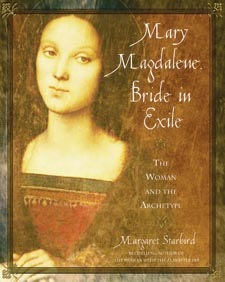Ave Millennium!
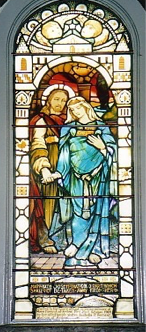
***********************************
1-27-16
Reflections on my Life's Purpose
Copyright 2015, Margaret L. Starbird. All rights reserved.
In Autumn of 1983, my dear college friend Ann Learman Requa came to visit me in Alexandria, Virginia. During our long weekend of conversation Ann suggested I should read a recently published book called Holy Blood, Holy Grail, insisting that I would find it interesting because of my passionate devotion to Jesus Christ and interest in the origins of Christianity. A few days later I was able to duck out of my house full of kids and make my way to the Sherwood Hall Publis Library, where I found the recommended book in the card catalog (long before computers!) and then on the shelf. The front cover stated the title: “Holy Blood, Holy Grail.” But the back cover suggested that Jesus was married and that his wife and progeny fled Jerusalem and survived in Western Europe. I almost dropped the book and fled from the library.
I tried to forget what I had read, but it haunted me. Could it be true?
Two years later I actually checked the book out of the library and read it cover to cover. At first, I thought it was blasphemous, but where there is smoke, there is often fire, so over a period of several more years of praying about the assertion of a married Jesus and researching the idea from every possible angle, I gradually became convinced that there was substance to the assertion. I spent spare hours of 1988-89 studying at Vanderbilt Divinity School in Nashville, using the extensive Divinity library for my research and running my findings past dear friends in my Emmanuel prayer community. Because I was raised Roman Catholic and had lived and studied in Europe in high school and later on a Fulbright student fellowship at a German university, much of the material—even Latin inscriptions and artworks displayed in churches—was already familiar. My youthful passion for historical novels, my college studies in comparative literature and European culture and history, and my more recent years of independent study of Judeo-Christian Scripture and the original Christian community were the perfect background for this further research.
The fundamental questions I was trying to answer were three: Could Jesus have been married? If so, to whom? And how did we ever lose this precious Bride of the Messiah/Savior?
My husband was reassigned to Fort Lewis, WA, in the summer of 1989, so I continued my research through the interlibrary loan system at Grandstaff Library, and took instruction in Microsoft Word. My old Osborne computer was till using function keys and the printer was an old dot matrix.
In August, 1990, I booted up to type up what I knew, and over the next four weeks, I wrote The Woman with the Alabaster Jar, focussed on the Lost Bride in the Christian story, the Mary “called Magdalene.” Over the course of the following months, I edited and honed the manuscript, choosing medieval artworks to support my views of the “Great Secret,” and finally in June 1991, I submitted the manuscript to Bear and Company, a small house in Santa Fe, NM, that published works of comparative religion and alternative spirituality.
Two months later I received a reply from the editor-in-chief: “We’ve been looking all over the world for this book. We see 7,000 manuscripts a year and we publish twelve. We’re going to publish yours.”
So that’s the explanation of how my first book came to be published in April 1993. The Roman Catholic Church had already tainted its reputation and credibility with various publicized scandals during the preceding decade, so many devout Christian people were beginning to ask, “What else did they forget to tell us.” My story of the lost Bride who fled to safety in southern Gaul after the Crucifixion of the Sacred King reached a receptive audience in many Christian communities and struck a chord. The story of the Sacred Partnership of Jesus and Mary Magdalene at the heart of the early Christian movement was to have been our birthright, but instead their story had been suppressed for 2000 years, with tragic consequences for civilization. The Western world had been worshipping Jesus as Supreme King—Ruler and Judge—but stripped of his feminine counterpart, a distortion that created a civilization based on male preferences—a distortion which, if not mitigated by relationship with true feminine energies, culminates in materialism, hedonism, and violence—the “unintended consequences” of the systematic denial of the Feminine.
Legend had promised that when the Holy Grail—the symbol of the Lost Bride—was found, the land would be healed, but the story had sadly remained hidden for far too long. By the 1990’s, the minds and hearts of humankind had become so male-oriented, so reliant on rational thought rather than common sense and wisdom, so entrenched in the power model of patriarchy, even to the point of preferring male children over female, it was time to envision a world where masculine and feminine were honored together as “Sacred Partners,” where everyone could live happily ever after as all our fairytales had promised!
Response to my first book was so encouraging that I wrote and published six more volumes over the next fifteen years, books that emphasized the tragedy and disaster of having silenced Mary Magdalene and the need to reclaim the “Divine Feminine” and her gifts of intuition, body wisdom, relatedness, and compassion, gifts incarnate in the woman who had walked hand-in-hand with Jesus and had remained loyal at his cross and tomb, rejoicing in his victory over death.
In April 2003, ten years after my “Alabaster Jar” was published, a block-buster best-selling work, The DaVinci Code, written by thriller-novelist Dan Brown, mentioned two of my books as inspiration for his research—launching them into translations into 17 languages. By this time, the world wide web was up and running; my website was generating emails from all over the world with questions about my beliefs, affirmation of my spiritual journey, and invitations to share my work with Christian communities around the world. Over about a decade I travelled extensively, often two weekends out of every month!—including trips to Europe, Canada, and one to Brazil—where I presented lectures and seminars focussed on Mary Magdalene—woman and archetype. Countless radio and internet interviews featured my work, and I was filmed answering questions for numerous documentaries that aired on the History and Discovery cable channels and on ABC—all the unexpected consequence of having written The Woman with the Alabaster Jar—reclaiming Mary Magdalene as the lost wife and beloved of Jesus Christ and the Sacred Marriage at the very heart of the Christian story.
* * * * *
Copyright 2015 by Margaret Starbird. All rights reserved.
5-18-15
Who were the Albigensian Heretics?
This 35th anniversary of the eruption of Mt. St. Helens and the pouring out of Spirit Lake into the valleys of western Washington State, seems an appropriate date to discuss a new and controversial theory about the medieval Cathars proposed by Dr. Mark G. Pegg, author of “The Corruption of Angels: The Great Inquisition of 1245–1246” and “A Most Holy War: The Albigensian Crusade and the Battle for Christendom.” http://en.wikipedia.org/wiki/Mark_Gregory_Pegg
This is a link an interview with Dr. Pegg on YouTube: https://youtu.be/O4-imkYbPWw https://youtu.be/O4-imkYbPWw
The topic :”Why The Cathars Never Existed”—5-16-15
Summary of Dr. Pegg’s theory: Cathars are known as the greatest heresy of the Middle Ages, perhaps in all of western culture. Yet new scholarship reveals that the Cathars never existed. They were a fabrication and projection of both heresy hunters and romance hunters. We deeply understand one of the greatest historical mistakes in all times, as well as how it forces much of medieval history to be completely rewritten, including that of Christianity...and Gnosticism and Occultism as well.
Prof. Pegg has a Ph.D. from Princeton and specializes“in scholarship of the Albigensian Crusade and the Inquisition, the history of heresy, and the history of holiness.”
******************
Margaret Starbird
Comments after listening to this entire interview with Dr. Pegg on YouTube: I agree with his assessment that “Catharism” did not exist as an organized religion with central leadership, foundational documents, and canonical doctrines in the 12-13th centuries. What DID exist were numerous groups of people (contemporaries of St. Francis of Assisi) who used the Gospels (translated into their own Old French dialect, the langue d’oc), to interpret the presence and teachings of Jesus in ways that challenged the rigid hegemony of the Roman Catholic hierarchy. The German word for “heresy” is “Ketzerei,” which is suggested as a possible source for the word “Catari” (Cathars). But the Latin root (“cathar”) means “pure.” Apparently medieval heretics claimed that their faith was “purer” than that of Rome. St. Bernard of Clarivaux was sent to examine the heretics of southern France and proclaimed that no sermons were more Christian than theirs. They called themselves “Christians.”
My own belief is that these “heretics” (now called “Albigensians”--for the general region where they lived near the city of Albi—or, alternatviely, “Cathars”) were actually Christians who embraced the Gospel of John with its radical message that Christ was present with them and within them in their daily lives and “walk with the Spirit.” Researchers have always known that medieval “Cathars" didn’t leave charters and documents. They were living and preaching “life in the Spirit”—not creating a formal religion.
Also permeating the underground faith of the region was the “great secret” that Jesus and Mary Magdalene were “Beloveds”—attested in a “History of the Albigensians" written in 1213 by Pier vaux-de-Cernay. I have visited the church in Beziers where the “Cathars" and other villagers who sought sanctuary were burned to death when the church was torched on Mary Magdalene’s feast day, 22 July, 1209. Pier Vaux-de-Cernay, a chronicler who wrote an account of the event stated that it was Divine Providence to punish the Cathars on that day for their slanderous belief that Mary Magdalene and Jesus were lovers. Other medieval documents assert “Cathar" belief that Jesus and Mary Magdalene were husband and wife, and apparently was grounds for the Roman Catholic Church’s eagerness to suppress them. The annals of the Inquisition would not record this belief of the heretics; why would they want to perpetrate the very heresy they are trying to squelch?
As discussed in two of my books, “The Woman with the Alabaster Jar” and “Mary Magdalene, Bride in Exile,” the art and artifacts of medieval Europe retain evidence for the heresy of the “Sacred Partnership” of Jesus and Mary Magdalene. Dr. Pegg may well be correct in his view that “Catharism” never existed as an organized religion, but the fact that P. aux-de-Cernay's “History of the Albigensians” was written in 1213 would prove that the heresies of Provence were virulent and brutally suppressed by the Church of Rome. Those heresies were an anti-clerical “grass roots” movement that grew out of the Gospels themselves—encouraged by wandering preachers traveling in pairs. In a way they are like the modern “Tea Party” movement— a group of like-minded citizens united in the belief that the central government in DC (like the Roman Church of the 12th -13c) is hopelessly corrupt and is distorting their "foundation documents" and teachings (the Constitution of the USA today, the Gospels in medieval Europe). The “heretics” in each case are only loosely connected to one another in the “movement” by certain core values—not in any formal, institutional sense. They are all independent “cells” of a greater body.
I was amused that Dr. Pegg mentioned “The DaVinci Code” in the interview, since Dan Brown, a novelist writing fiction, borrowed his ideas from “Holy Blood, Holy Grail,” and from two of my books (which Brown mentioned in “The DaVinci Code.” I would have liked for De. Pegg to have commented on the massacre at Beziers in 1209 and on the siege at Montsegur and burning of 200+ heretics there in 1244—are they not history? Are they not incontroverible proof that “Cathars” existed and were persecuted into near extinction in the 13th century?
* * * * * * *
2-13-15
A Valentine Meditation on the Way of the Heart
“We have a treasure, not made of gold,
in earthen vessels, wealth untold—
One treasure only, the Lord, the Christ,
in earthen vessels….”
Years ago a friend tried to explain to me that the “earthen vessels” in this song made popular by Carey Landry referred to the chalice and plate used at the altar during a Catholic Mass, the vessels that contained the wine and bread transubstiated into the body and blood of Christ during the Eucharistic ritual (Holy Communion).
I beg to differ.
The “earthen vessels” of the song are human beings who have embraced and cherish “Christ consciousness” in their very selves. They become the living “marriage” of flesh and divinity, the “incarnation” of Godde in us. The goal of humanity and each human is to become “perfected” through experience in cooperation with grace during a lifetime, to “put on Christ” by imitating the integrity, courage, generosity and selfless service revealed by Jesus in the Gospels. They become willing vessels—the hands and feet of Godde. Of all the Saints in Cihristian history, the pre-eminent model for this “union with Christ” is the Mary called “the Magdalene,” the “ointment-bearer” whose iconography so often includes a sacred container.
Here are some further thoughts on the nature of “vessels”—
Our Earth herself is a vessel, unique in our galaxy, the archetypal material “womb of life” (macrocosm) while each woman is potentially a vessel of life (microcosm) in her ability to bear children. On a spiritual plane, each human—male or female—is a vessel of flesh (earthen vessel) imbued with consciousness (divinity). And the “vessel of life” within each entity is the chalice of the heart—the “container” or “vessel” of our life’s blood. Among some ancient cultures, the cranium was considered the “vessel” of the personality. Celts in France practiced the original silver-plating of drinking vessels, dipping skulls in silver to preserve them as drinking vessels from which they symbolically imbibed personality traits of a hero or ancestor.
One of the current themes of spiritual discourse in our time is the “marriage of head and heart”—the “sacred union” of reason and intuition, of power and love, of masculine and feminine ways of knowing and being, summed up in the “sacred marriage” (hieros gamos) of the two opposite triangles in the “Star of David.”
Recently revealed and acknowledged is the “Lost Feminine”/Bride of the eternal Bridegroom of the Christian millennia, in the person of Mary Magdalene. Restoring this “Bride and Beloved” of Jesus to his side enables us to honor the “Divine” as a sacred partnership or wholeness—a reconciliation of head and heart. It brings us full-circle, back to the original group of followers who honored Jesus and Mary as partners and who travelled in pairs (couples) to proclaim the Good News of the Incarnation and the Risen Christ—Emmanuel, God with us!
Renowned among early “Church Fathers” was a man called Valentinus (100-180 AD). His followers developed teachings that included a “bridal chamber” theology, defined as a mystical marriage with a celestial counterpart (Christ) that illuminates the spiritual life of a Christian and bonds him heart-to-heart with Christ. Love becomes the great motivator for human endeavor, and the “Christ-lover” remains in direct communication with the “Beloved” (i.e. “Gnostic” knowing). Followers of Valentines were later declared heretic, but his influence remained strong until the late fourth century when Constantine’s bishops moved to consolidate Christian teaching and practice by placing “deviant” teachings under anathema. Most documents deemed heretical were burned, while others were hidden in jars in the Egyptian desert (the Nag Hammadi Library) to await discovery in the mid-twentieth century.
Although many of his teachings were banned, the influence of Valentinus, survived. The modern legend of “St. Valentine” retains elements of his story and teachings of the mystical marriage of flesh and divinity—messages between lovers secretly transmitted behind the backs of “orthodoxy.”
" And now there abide these three: Faith, Hope and Love. But the greatest of these is Love.” (1 Cor. 13:13).
* * * *
11-24-14
Review of The Lost Gospel
Review: The Lost Gospel
by Margaret Starbird
copyright 2014
Last week Professor Barrie Wilson, Professor of Biblical Studies emeritus at York University in Toronto, and Simcha Jacobovici, TV’s “Naked Archaeologist, published research they’ve been working on for six years under the title The Lost Gospel. The volume is a tour-de-force, carefully documented—their interpretation of an ancient Syriac text called “Joseph and Aseneth” and several accompanying cover letters recently discovered in the British Library. The Syriac copy examined in this work is from the 6th century, but earlier copies of the work are known to exist, the original probably written sometime during the 1st-3rd centuries and, although known to scholars, according to our current authors, widely misunderstood. This work by Wilson and Jacobovici attempts to set the record straight.
Given the context of other documents bound within the same leather cover as the examined document along with internal elements in the text itself, I agree with the assessment of the researchers that the text is Christian, not Jewish, and that the two main characters named in the title, Joseph and Aseneth, are probably proxies for Jesus and Mary Magdalene in the work that appears to be apocryphal. The story certainly has very little resemblance to any of the four canonical Gospels of the New Testament, all of which explicitly name Jesus and Mary Magdalene, their friends and various historical figures (Herod, Pilate, Tiberius, Caiaphus). Aseneth/Mary Magdalene’s message in the final chapter, “Forgive your enemies and pray for them” is a basic tenet of Christianity, and her teaching of the “brothers” is reminiscent of the Gnostic “Gospel of Mary.” One of the teachings of Gnostics was that Mary Magdalene was the “enlightened” heir of Jesus’ teachings who instructed and encouraged the male apostles.
I also agree with the authors’ determination that “Joseph and Aseneth” is Gnostic and Valentinian rather than “orthodox” or “mainstream” Christian. The work is ostensibly an allegory and may, as Wilson and Jacobovici suggest, contain kernels of truth, but it cannot be viewed as historically accurate with regard to assertions it provides about the wedding of Joseph and Aseneth (i.e. Jesus and Mary Magdalene), the names or number of their children, identity of Jesus’ brothers or Mary’s parents, and other speculative details “coded” in the text.
While claiming “factual proof” is a stretch, The Lost Gsopel is intriguing and makes many interesting points, including belief in the sacred marriage of Jesus Christ and Mary Magdalene, his identification with “Helios,” the sun god Apollo, and her association with the moon goddess Artemis (Chapters 9 and 10). Of particular interest are the images of zodiac mosaics found in what must have been early (3rd-4th c.) Christian churches rather than Jewish synagogues in Galilee, a region universally cited as the original hot-bed of revolutionaries and messianic movements, including the early Christian movement, as well as a melting pot of Middle Eastern cultures, religions and philosophies. One mosaic, the Hamat Taverya found near the city of Tiberias located on the Sea of Galilee, depicts the sun god Helios poised directly under the line separating the signs of Ares (Ram) and Pisces (Fishes), illustrating the precession of the equinoxes at the exact dawn of the “Age of Pisces” of which Jesus Christ is said to be Lord. Jesus died a “Ram” (Lamb of God) and was raised a “Fish”—the ICHTHUS of Christian iconography. This mosaic clearly illustrates the “Helios” of the New Age dawning.
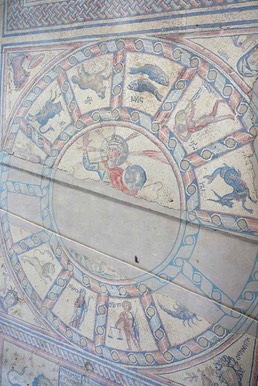
Another mosaic, found in the monastery of Lady Mary near Beit She’an (Scythopolis), depicts the sun god with his consort, the moon goddess. Traditionally this image would be attributed to Jesus and his mother, but The Lost Gospel makes a very good case that the original “Virgin” for the Gnostic community of origin was the Mary “called Magdalene.” It’s interesting to note that the zodiac sign partnered (directly across the axis) with the Sign of the Fishes is “Virgo”—the Virgin. The Mary whose title associates her with the “vessel of the fish” () (ancient symbol for goddesses of love and fertility) is “the Magdalene.” Wilson and Jacobovici, in associating Mary Magdalene and her tower (“Magdal”) with the Greek goddess, note that Artemis is a fisher and sometimes called Diktynna—“Artemis of the nets.”
In John 21:6, the metaphor for the church, the “153 fishes in the unbroken net” bears the isosephia (“gematria”) of “H Magdalhnh”—153, a denominator of the ratio (265/153) used by ancient geometers to refer to the square root of 3 illustrated in geometry by the vesica pisces (vessel of the fish). There is no chance that any of these “fishy” elements are accidental. John’s Gospel uses the “153 fishes in the unbroken net” as a metaphor for the “ekklesia” / church, for which the apostles of Jesus are “fishers of men.” These elements place the origins of Christianity at the beginning of the dawning Age of Pisces, whose sign is not one fish, but two, forming a “yin/yang” symbol of partnership and the union of unreconcilable opposites.
Suggestions in The Lost Gospel (Chapter 12) that Jesus was a mamzer (Dr. Bruce Chilton’s hypothesis) or that he was an illegitimate son of a Roman soldier named Pantera, as suggested in the 2nd century Talmud, are in my view unconvincing. “Virgin birth” was alleged for numerous gods and even for Plato and Augustus Caesar in the Hellenized Roman empire. If the Gospel Jesus had been a mamzer, he never would have been allowed to teach in a synagogue (as in Mark 1 and 6, Matt. 13, et alia). The most logical deduction is that Jesus was the natural son of Joseph (as indicated in the genealogies in the Gospels of Matthew and Luke, although these do not match), a human being “chosen” and “formed in his mother’s womb” like the prophet Jeremiah:
"Before I formed you in the womb I knew you,
And before you were born I consecrated you;
I have appointed you a prophet to the nations.” (Jeremiah 1:5)
Paul states in an epistle that Jesus was descended from King David “according to the flesh” (Rom. 1:3) and the Book of Revelation calls him “Lion of Judah” (refering to his human lineage as a descendant of King David) while the Gnostic Gospel of Philip also asserts that Jesus was the son of Joseph. I believe the “Pantera” story is a 2nd century fiction designed to counter claims of “virgin birth” asserted by early Christians who were convinced that Jesus was Divine—a fiction subjecting the god of the Christians to epithets of “bastard” and his mother a “harlot.”
Discussion of the “Bridal Chamber” and Valentinian Gnostic beliefs (Chapter 11) was informative and well-documented, although I would recommend the work of Victoria LePage (Mysteries of the Bridechamber) for further reading. Not mentioned in discussion of the Eucharist in this chapter is the Eucharistic prayer in the Didache:
9:2 First, concerning the cup. We thank thee, our Father, for the holy vine, David thy Son, which thou hast made known unto us through Jesus Christ thy Son; to thee be the glory for ever.
9:3 And concerning the broken bread. We thank thee, our Father, for the life and knowledge which thou hast made known unto us through Jesus thy Son; to thee be the glory for ever.
The “thanksgiving meal” revealed by Paul in 1 Cor. 11:23-26 echoes pagan practices in the cult of Dionysus—a Hellenistic “mystery religion” and has very little in common with the ritual of the Didache. Paul is the earliest written source for the words relating the bread and wine to the body and blood of Jesus, words that managed to find their way into the three Synoptic Gospels written more than a decade later than the epistle. It is important to note that John’s Gospel does not include this institution of the Eucharist at the Last Supper, substituting instead Jesus’ washing of his apostles’ feet.
Discussion in chapters 13-15, identification of Pharoah’s son with Germanicus, a son and heir of the Roman emperor Tiberius, and detailed discussion of political machinations of Roman and Jewish royals in the first century was informative, but raised numerous questions. The text of Joseph and Aneseth states that two brothers of Joseph, Dan and Gad, collaborated with Pharoah’s son in the plot to kill Joseph and his children. Which two of the brothers of Jesus could have been so disloyal? Or are we to equate the “brothers of Joseph” with the twelve apostles? Other than Judas, which other apostle would have collaborated with “Pharoah’s son”?
And, even more disturbing, the ancient text asserts that “Joseph” lived long, ruled for 48 years after the death of Pharaoh, and mentored the grandson of Pharaoh “all of his life,” yet we know that Jesus was crucified probably about ten years after the events narrated in the story of Joseph and Aseneth. Was the author of this text who is allegedly reporting on the marriage of Jesus and Mary Magdalene and an attempt on their lives not aware of actual biographical details of Jesus’ life and death? The “coded” story by proxy breaks down.
With regard to the politics of Jesus, why does The Lost Gospel never refer to Jesus as a “Nazorean,” an epithet found in the Gospels designating him a member of a faction of the Zealot party? In the first century, the town now called Nazareth was probably a farm or, at most, a hamlet. It was not a village and did not have a synagogue. Many current scholars think it unlikely that Jesus was “from Nazareth,” but rather that the town was a cover story used by the authors of the Gospels trying to hide the Zealot-Nazorean connections of Jesus and his close friends and family.
The story in this Syriac text is allegorical fiction. If Joseph and Aseneth are “stand-ins” for Jesus and Mary Magdalene as The Lost Gospel hypothesizes, a case might be made that Mary Magdalene was a Gentile priestess, but this is not the position of the canonical Gospels which have her keeping the Jewish Sabbath before visiting the tomb of Jesus on Easter morning. In her day, the town later called “Magdala Nunnayah” (Tower of the Fish) was called “Taricheae” in all extant documents. I am personally convinced that this Mary, the sister of Lazarus and Martha, was given the title “H Magdalhnh” with its very significant gematria (153) based on the prophetic passage in Micah 4: 8-11 that sums up her post-Crucifixion plight:
“As for you, O Magdal-eder, (Watchtower of the Flock),
through you dominion will be restored to the Daughter of Sion.
Why are you crying? Have you no King?
Has your master perished that you cry along like a woman in labor? …
Go now and dwell in the open fields.
To Babylon shall you go and from there you shall be rescued.
Nations will gather against you; they will defile you (call you ‘unclean’).”
In the role of ancient goddesses crying over the “Sacred Bridegroom-King,” Mary Magdalene comes to the tomb on Easter morning and finds Jesus resurrected in the garden. But she is again separated from him and finally taken as a political refugee into exile. The suggestion that she remains in Jerusalem after the Crucifixion is very unlikely, since she is never mentioned in any of Paul’s epistles, the earliest Christian documents (written 50-65 C.E.), or in the Book of Acts (70-90 C.E), the sequel to Luke’s Gospel.
I would like to offer a different hypothesis about the Story of Joseph and Aseneth. As suggested in The Lost Gospel, I can believe that the author of the story was a Gentile, probably a convert to a 2nd-3rd century Valentinian-Gnostic Christian sect that honored Mary Magdalene as the “Sacred Bride,” the wife of Jesus and mother of his children. This scenario is familiar from the Gnostic Gospel of Philip which calls the Magdalen koinonos (companion, consort) of Jesus. Using the “pesher” interpretation of Hebrew Scripture as prophecy in the manner employed by authors of the canonical Gospels and other early Christian texts, the author of the allegory uses Psalm 45, the “Nuptial Ode of the Messianic King,” as prophetic of Mary Magdalene, styling her as a Gentile priestess. The “Daughter of Tyre” in the psalm becomes the daughter of an Egyptian priest in the story of Aseneth. But on a higher plane, she is the “type” or “personification” of the Gentile Church that embraces Jesus as “Son of God” and begets generations of believers. Romans and Jews (Pharoah’s son and Joseph’s “brothers” in the story) conspire to destroy Jesus, Mary and their progeny (communities of Christians that celebrate Jesus and Mary Magdalene as partners), but their plots miscarry and Jesus becomes the honored mentor of Pharoah’s grandson all his life (possibly a reference to the Emperor Constantine, which would suggest that this piece is a 4th century text).
This allegorical interpretation makes sense of the document in context without claiming any specific details as “proof.” Early Christian apologists understood Mary Magdalene as the prototype for the Church/ekklesia, the community of Christians. As the woman who anointed the Sacred King and met him resurrected at the tomb, she was the representative of her land and people. Yet she is styled “a sinner” in Luke’s Gospel (10: 7:37), and a reformed harlot in Christian tradition. This theme of the “Bride of God” is an ancient one, recurring in Jewish Scriptures, where the Jewish people are personified as a young woman chosen by Yahweh to be his Bride. Sadly, she betrays his trust, prostituting herself before false gods (Ezekiel 16). But God is faithful to forgive and accept her when she repents and turns to him, just as in the book of Hosea, God commands Hosea to remain faithful to his adulterous wife Gomer in hopes that she will return to him—as a sign of God’s love for his people.
When Aseneth changes her heart, destroys her idols, and becomes the bride of Joseph, she is acting out this same scenario of the representative of her land and people repenting their idolatry and returning to the marriage covenant with Yahweh. In the canonical Gospels, Jesus represents Yahweh as “Bridegroom of Israel” in John 3:28-35 and in various parables: “ A certain king gave a wedding banquet for his son,” but the invited guests begged tp be held excused (Matt.22: 2-14). Christianity was, at its inception, a celebration of the sacred covenant of God with his people, represented by devoted husband and wife chosen to embody the archetype of the “Sacred Partnership” of Flesh and Divinity, the incarnation of God in us. That is the underlying tenet of Christianity, summed up in the name “Emmanuel.”
The “Kingdom of God” is a frequent phrase in the Gospels, described with a variety of metaphors. One of the most familiar is the “grain of mustard seed.” In a footnote. (chapter 17, note 9), Dr. Wilson and Jacobovici discuss the aphrodisiac nature of mustard seed and suggest that the parable of the mustard seed might be interpreted in light of “sacred sex.” But they fail to mention the fact that the gematria value of the Greek phrase “grain of mustard seed” is 1746, a “marriage” of the masculine (666) and feminine (1080) principles in the Pythagorean canon of sacred number. Plato calls the number 1746 “Fusion” (i. e. “union”), illustrating the same principle. In this parable, Jesus is saying that the “Kingdom of Heaven” is like the “sacred union” of masculine and feminine, the “irreconcilable opposites.” The issue of gematria is discussed more fully in my “Magdalene’s Lost Legacy,” a study of symbolic numbers in Cristian Scripture based on the ancient practice in Judaism and the erudite work of John Michell.
The Lost Gospel merits careful reading. The discussion of the ancient apocryphal text is complicated and thorough, including many peripheral points of interest. While I disagree with some positions held by the authors, the book enhances understanding of the politics and cultural diversity of various sects of early Christians in the Middle East of the first century. It’s an important contribution to the on-going dialogue about Christian origins.
* * * *
09-19-14
Thoughts on The Divinity of Jesus
The title of a recent book published by Dr. Bart Ehrman, “How Jesus Became God,” caught my eye today triggering me to provide an answer to this question here although I haven’t read Dr. Ehrman’s book.
Place yourself for a moment in the shoes of Mary Magdalene on Easter morning. According to John’s Gospel, you left the house alone at dawn to go to the tomb of Jesus. You wanted to be alone with your sorrow, to mourn at the cave where his followers had hastily placed the mutilated body of your Beloved just before sundown on Friday evening. As you approach the tomb, you noticed that the huge stone placed to close the cave carved into the hill had been rolled off to the side and the entrance was a gaping hole. Confused and distraught, you cautiously approached the dark cavity and peered inside. You paused, waiting for your eyes to adjust in the half-light of dawn. Now you could see the slab on which the corpse of Jesus had lain on Friday was bare except for the shroud cast casually across one end. The cloth that had covered his face was lying in a heap on the floor of the cave. (These details are reported in John's Gospel, chapter 20).
Your eyes opened wider. Instinctively you clapped your hand over your mouth to stifle a cry of astonishment and, turning, you fled from the tomb, back through the garden of Joseph of Arimathea and up the long path to the Mount of Olives to your home in Bethany. Other friends of Jesus were there in the courtyard, quietly sharing their thoughts about the traumatic events of the past several days culminating in the crucifixion of the Lord. You burst through the gate and blurted out your news: “The tomb is empty! Jesus is gone.”
The gathered Apostles, family and friends of Jesus stared at you in bewilderment and disbelief. They thought you had lost your mind. How could the tomb be empty? Peter and Lazarus brushed you aside as they started to run from the courtyard, out the gate and down the hill in the direction of the tomb. You followed in their wake and, arriving again in the garden, you encountered a man you believed to be the gardener. “Why are you crying?” he asked, quoting from the prophecy of Micah (4:9), “have you no King?” You asked him where they had laid the Lord.
Then he spoke your name: ”Mariam.” You recognized him and, overjoyed, rushed to embrace him. Gently he admonished you, “Don’t keep clinging to me,” and instructed you to tell his brothers that he was risen and would meet them in Galilee.
You rushed back to Bethany to spread the news: "Jesus is risen! He has defied death and lives! He promised to meet you in Galilee."
This amazing news of the Risen Lord spreads like wildfire throughout the Jerusalem, at first whispered from mouth to mouth by pilgrims gathered in the Holy City for the Passover festival, and then fairly shouted from rooftops: "Jesus is risen, just like Tammuz!"
The ancient mythology of the sacred King rising from his tomb, indigenous to the Middle East, is now incarnate in the resurrection of Jesus, the anointed King of Israel. Remember the Babylonian god Tammuz? In the book of Ezekiel, the women of Jerusalem cry over their beautiful god, the consort of Ishtar—“faithful son” and “husbandman”--brutally executed to ensure the fertility of the land. His mythology is similar to the stories of other gods of the region: Damuzi, Osiris, Attis, Adonis and Ba'al. Immediately this archetype of the sacrificed King--mutilated, entombed, and raised from death--is declared to be embodied in the crucified and risen Christ, now understood to be a god since an overriding pre-requisite of deity is eternal life in defiance of death. Invariably in the ancient myths and their liturgical rites, it is the Bride / consort of the King who goes to mourn at his tomb on the third day and finds him resurrected, a fact that tells us volumes about the Mary called "the Magdalene" who plays this role in the Gospel narrative.
Later doctrines of the continued presence of the “Savior” within the hearts and minds of the community of believers evolved and were articulated as varying degrees of Divinity were attributed to Jesus. Some insisted that he was the son of God by virtue of his Baptism in the River Jordan ("This is my beloved Son. Hear him!”) Others claimed he was born of a virgin, a myth common to many gods and heroes in the Hellenized Roman Empire. Still others claimed that Jesus was pure spirit and that his flesh was an illusion, the heresy of Docetism. I surmise that Dr. Ehrman’s book deals with the evolution of the doctrine of Christ’s divinity, as does a pioneer book by Dr. Raymond Brown, “The Community of the Beloved Disciple” (published in 1978). But for the earliest strata of believers, the notion of the divinity of Christ was rooted in the message of the empty tomb—the ecstatic message carried by Mary Magdalene to the community of followers on that first Easter morning:
“He is not here. He is risen”
* * * * *
06-02-14
A Timely Lesson
In 1983 Ann Requa, a dear friend since my college years at the University of Maryland, told me about Holy Blood, Holy Grail, that she thought I needed to read the book, and that I could probably find a copy in my local library. A few days later I looked the title up in the lubrary’s card catalogue, found it listed, and discovered it in the stacks. The front cover said Holy Blood, Holy Grail, as expected. But the back cover asserted that Jesus was probably married and that his wife and progeny survived the Crucifixion and fled into exile as refugees in Gaul. At the time in 1983 I was still “singing in the choir” and teaching catchism classes for the Roman Catholic Church, and I was definitely not inclined to accept any notion that I perceived as so clearly blasphemous.
For two years I did not read the book my friend had recommended, but, radically disillusioned after reading “In God’s Name” by David Yallop (an exposé of the Vatican Bank scandal and alleged assassination of Pope John Paul I), I returned to the library in 1985 and checked out Holy Blood, Holy Grail. I read the book from cover to cover, still reluctant to accept the fundamental premise of the marriage of Jesus to his “consort/companion” Mary Magdalene. I asked myself agonizing questions: How could we have lost the Bride of Jesus? How could the Church have hidden such a momentous secret for so many centuries? Surely the Church fathers would have told us if Jesus were married with children! I’ve recorded details of my quest for the truth of the Magdalene “story,” published in The Goddess in the Gospels in 1998. Numerous synchronicities and Scripture passages that confirmed the sacred partnership of Jesus and Mary Magdalene at the heart of the Christian story made their way into that book, so I won’t repeat them here.
But some important illuminating incidents didn’t make the “cut” for that book, including one I didn’t fully understand at the time, but which has grown on me over the years and has become a very important key understanding of the tragic consequences of the "Lost Bride."
One Monday afternoon in 1986 while I was doing my usual chores, I sent out a special request—asking God to have the mailman deliver something to my mailbox that would confirm or deny the assertion of Holy Blood, Holy Grail that Mary Magdalene was the “Bride of Christ.” I had no idea what I would consider a proof or denial of the theory—but I asked for it anyhow.
When the mailman had passed, I ran to the box to see what he had left there. To my befuddlement, the only item in the box was a small package, about 7” by 10”, from a company that advertised ant farms. Opening the container, I remembered having ordered the item weeks before so I could teach my children about the almost legendary work-ethic and industry of ants. The advertisement for the “farm” stated that viewers could watch the community of ants through the plastic walls of the box--tunneling and moving food particles through the network of tunnels the worker ants would create. I was sad that I hadn’t received an answer to my prayer for the con-firmation or denial of the “married Jesus” hypothesis, but I decided maybe my request had come too late--probably the mailman had already packed his bag and started on his rounds.
When the kids got home from school, they were excited the ant farm had arrived. They bent their heads together over the instructions and unpacked the package to set up the ant farm. There was a narrow box with clear plastic panels on each side, a package of sand and a small packet containing the live ants! Carefully we assembled the project, added the ants and watched as they began scurrying to and fro digging their first tunnel. Sure enough, over a period of hours, the ants built tunnels and started carrying food particles from place to place. The kids watched with fascination for a few minutes, then went on to other activities, returning at intervals to see how the ants were doing with their project. As advertised, the ants continued to scurry around behind their plastic walls tunneling and carrying food particles.
At breakfast the next morning, the kids inspected their ant colony performing its activities--and rushed in again after school. For several days the ant farm was a magnet for attention. Neighborhood children were invited in to watch the ants. Everyone was enjoying observing ants busily scurrying around inside their plastic box, tirelessly tunneling and carrying food particles hither and yon.
But by the end of the week activity gradually slowed and then finally ceased. The ants had apparently worn themselves out and one at a time had begun to die off. After another forty-eight hours, we sadly agreed that the experiment was over and that it was time to trash the ant farm. We had gotten the message that the ants were an industrious community, but somehow they had failed to thrive. We carried the plastic box out to the back yard and dumped the experimental ant farm onto the ground, hoping any survivors might find a new colony and home outdoors.
Much later I realized that I actually HAD received an answer affirming the “sacred marriage” in the mailbox that Monday afternoon. The meaning was clear. The ant community had failed to thrive because they had no “organizing principle” at the heart of their “farm." The goal of any community, its "reason for being," is the continuity and nurturing of life.The ants in our farm had no Queen and therefore, no reason for their labor, no progeny to nurture, no “vocation.” All their activities were ultimately just “busy work”—and wasted.
I believe the earliest Christians established their community with the partnership of Jesus and Mary Magdalene at its heart--modeled on the “Song of Songs,” where the devoted relationship of the “Beloveds” was a mirror of God’s passionate love for his people. While Jesus represented Yahweh as “Bridegroom,” (an epithet confirmed in various Gospel passages), Mary Magdalene represented the people of Israel, the “Daughter of Sion,” as Sister-Bride and Beloved. Their union was celebrated at all levels of human experience, exemplified in the “Sacrament of the Bridal Chamber,” in early Christian communities.
In his letter to Corinthians 5:9, Paul states that Cephas and the brothers of Jesus and the other apostles all “travel around with their sister-wives.” Where did Paul get that phrase, if not from the original Christian community that modeled itself on the “Song of Songs,” Scriptural poetry derived from an ancient rite of “sacred marriage,’ where the Bridegroom frequently refers to his Beloved as “My sister, my spouse: “You have made my heart beat faster, my sister, my bride” (SoS 4:9); “a garden inclosed is my sister, my bride” (SoS 4: 12); and “I have come into my garden, my sister, my bride” (SoS 5:1).
English translations of Paul’s letter invariably call these sister-wives “Christian sisters” even thought the phrase in the original Greek does not contain the word “Christian” at all.
Why did the Jerome and later translators of the Greek Gospels wish to obscure the knowledge that the closest associates and kin of Jesus traveled with their “sister-wives” as missionary couples, bearing the “Good News” to the farthest outposts of the Roman Empire? When he sent them forth “two by two,” Jesus was apparently sending couples, not pairs of males, according to Paul, the earliest witness to Christian practices.
It’s a good thing Noah didn’t misunderstand God’s instructions about bringing the animals into the ark “two by two” as the early church fathers apparently misunderstood the instruction of Jesus to preach the “Way of the heart” in a couples’ ministry!
* * * * *
4-8-14 "Veronica’s Veil"
Years ago I drew a card from a deck depicting examples of various species from the animal kingdom. I half expected a lioness, since my maiden name was Leonard (lion-hearted). Instead, the card I drew was a dragon-fly. I was clueless to any connection with that “totem,” until I looked up references and discovered that the dragon-fly is an “emissary of the Goddess” and a “destroyer of illusions.” Under that aegis, I am prepared to discuss what I believe is a pious Easter legend—that of “Veronica’s veil.”
As we approach Easter, we return to the Gospel narratives of the Passion of the Christ, which begin, I believe, with the anointing of the sacred King, soon to be crucified. Mary, his bride bends over him, pouring her precious ointment on his head, reserving some for his feet as well. Her tears fall on his feet; she dries them with her hair (John 11:2; 12:3). Later, we find Mary Magdalene standing at the foot of the cross with Mary and the “Beloved Disciple” who is never named. We have heard these stories before in the Christian liturgies of the “Easter Cycle”—liturgies derived from ancient mysteries of the sacrificed king, executed at the spring equinox on behalf of his people.
Among the powerful and emotion-laden stories of the Passion of Jesus and associated Easter mysteries we find the legend of Veronica’s veil. Search as we might, we discover no mention of Veronica in any Gospel. I’ve thought about this anomaly over the years. Where did the legend come from? And what is it telling us?
Veronica is said to have taken pity on Jesus as he carried the heavy beam of his cross on his way to Golgotha, along the street known as the Via Dolorosa—the Way of Sorrows--in Jerusalem. With a piece of fine linen Veronica wiped the sweat and blood-covered face of Jesus. As the sorrowful procession moved on, Veronica was left holding a cloth that bore the image of Jesus’ face, the image known as “Veronica’s veil.”

The Road to Calvary with Verionca’s Veil by Giovanni Cariani
Veronica’s name is an anagram for the Latin words, vera icon, meaning “true image.” So, it follows that the story of Veronica wiping the face of Jesus is "story"--not fact—rooted in John's Gospel (20: 3-7), describing the tomb of Jesus with a shroud and a facecloth:
"So Peter and the other disciple went forth, and they were going to the tomb. The two were running together and the other disciple ran ahead faster than Peter and came to the tomb first; and stooping and looking in, he saw the linen wrappings lying there; but he did not go in. And so Simon Peter also came, following him and entered the tomb; and he saw the linen wrappings lying there, and the face-cloth which had been on His head, not lying with the linen wrappings but rolled up by itself.
From this passage we can surmise that there was a shroud (linen wrappings) and a "face cloth" found in the tomb on Easter morning. Mary Magdalene, being the first person to arrive at the tomb, was the first witness to the image of Christ on the linens. From reading histories of the Shroud of Turin, we know that the early community of Christians were aware of these pieces of cloth and preserved them because the bore the image of Jesus (the "true icon").... Since items that had touched a corpse were "unclean" in Judaism, both these items were characterized as "face cloths": The shroud was folded up so that only the face was visible and placed inside a box with a glass cover. Eventually it found its way to Constantinople, where it was paraded at Christian festivals and hidden in a niche in the city's wall. When Frankish Crusaders sacked Constantinople in the 1203, they stole the shroud and took it back to France with them, where it was probably venerated by Knights Templar, and ended up in the hands of heirs of Geoffrey de Charney, the Templar executed in 1314 with the Grand Master Jacques de Molay.
The "face cloth" has a different history. Called the "Suderium," it has been housed in Oviedo, Spain, since 631. When blood and lymph stains from the Suderium are matched against the stains and markings in the Shroud of Turin, they have amazing "congruence" and the blood type “AB” in both cloths is the same---proving that both are from the same source--the crucified Lord, the Sacred King.
So I've concluded that the real "Veronica's veil" is actually the cloth long venerated as the Suderium of Oviedo. Those early Christiains who knew the cloth existed made up a story to explain its existence and its miraculous image --a story that failed to mention its contact with a corpse that would have rendered it "unclean" according to Jewish practice.
How could Mary Magdalene and her friends and family have ever been persuaded to wash--or burn--the amazing “true image” (the “vera icon”) discovered on the burial facecloth of their Beloved? Would they not have preserved it exactly as they found it? Would they not have called the sacred cloth the "Vera icon"?
In memory of her--
Margaret
* * * *
Copyright 2013. All rights reserved.
5-19-13
Templars, Tombs and the Resurrection
The Resurrection of Jesus and the sacred reunion of the Archetypal Bridegroom and his Holy Bride in the Garden on Easter morning is the foundational cornerstone of Christianity.
The anointed “sacred king” was, as in many ancient myths and liturgies, arrested at the Spring equinox, then tortured, mutilated, executed and laid in a tomb. On the third day, his bereaved spouse returned to the tomb to mourn his death and was overwhelmed with joy to discover her Beloved resurrected in the Garden. This is a story reaffirmed in the Christian Gospels, a story rooted in pagan cults of the Near East since the Neolithic period, in myths of ancient divine couples Inanna and Dumuzi, Ishtar and Tammuz, Astarte and Baal, Venus and Adonis, Cybele and Attis.
The early architects of established Christianity were well aware that the Passion narrative, beginning with the anointing of Jesus by Mary at the banquet in Bethany—an action proclaiming him “Messiah” of Israel—and ending with the ecstatic reunion of the Beloveds in the Garden, bore strong resemblance to other “hieros gamos” liturgies of the ancient Near East. Justin Martyr (c. 100-165) declared that pagans had copied (plagiarized?) Christianity in advance, while Saint Jerome (340-420), after visiting the cave near Bethlehem where Jesus was allegedly born, stated his outrage that in that very grove pagans had lamented the death of Tammuz (Adonis).
I believe the Resurrection of Jesus was a spiritual event. A recent book, “The Sign” by Thomas de Wesselow (2012), reveals his theory that the image in the Shroud of Turin was perceived by Mary Magdalene and the entire circle of Jesus’ close friends as proof that He was resurrected on a spiritual plane—which is where Christians encounter Him still. The Gnostic Gospel of Mary affirms that Mary Magdalene continues to enjoy communion with Jesus beyond the grave, an experience similar to that of mystics and “Gnostics” throughout the Age. “Christ” is beyond death, yet lives! The “Myth” of the eternal return of Life and rebirth in the Spirit is celebrated in the Easter Mysteries by Christians worldwide. The sacred reunion of the Divine Complements is our heritage.
In 2000 I published a short book entitled Tarot Trumps and the Holy Grail: Great Secrets of the Middle Ages in which I speculated in passing that the heretical secret guarded by the Order of the Knights of Solomon’s Temple was the knowledge that Jesus’ bones were contained in an ossuary discovered during their 12-13th-century sojourn in the Holy Land. This powerful brotherhood of warrior monks was claimed to harbor a secret that would destroy the Roman Catholic Church, and on Friday, 13 October 1307, the Templars were simultaneously arrested in every city in France and thrown into dungeons, undergoing heinous tortures to extract confessions of their heresy.
What was their secret?
Almost one hundred years earlier Wolfram von Eschenbach, the 13th century poet-author of the epic poem “Parzifal,” had asserted that the “Templiers” were custodians of the “Grail Family.” The “Great Secret” of the Templars appears be that Jesus was fully human—married with children—and buried in Jerusalem.
My conviction that the Templars were shown—perhaps even owned—the bone-box of Jesus is derived from the image called the “Charioteer” found among the trump cards of the Gringonneur/Charles VI/Estensi deck, which I believe is the earliest extant example of tarot trumps (as discussed in my Tarot Trumps and the Holy Grail). The Charioteer stands astride a conveyance that resembles a hearse. He wields a battleaxe and his toes point to the letters I and C, initials of Iesu Christi, visible around the edge of the pedestal on which he stands.
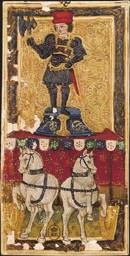
Whether this “Great Secret” of Jesus’ full humanity and burial is true or not, it was widely known and disseminated in medieval Europe. The Vatican’s “Holy Inquisition” was formed in Southern France in 1239 for the express purpose of wiping it out along with other heresies of the Languedoc. In his chronicle of the Albigensian Crusade, Pier vaux de Cernay wrote in 1213 that townspeople of Béziers were burned alive on the feast day of Mary Magdalene (22 July 1209) in retribution for “their scandalous assertion that Mary Magdalene and Christ were lovers.”
In recent years we have been provided information about several tombs discovered in the Southeastern suburbs of Jerusalem. In 2007 Simcha Jacobovici and his co-author Charles Pellegrino published The Jesus Family Tomb: The Evidence Behind the Discovery No One Wanted to Find along with a documentary about the “Talpiot Tomb,” revealing the intriguing fact that the 1st c. tomb, first discovered in 1980, contained ossuaries bearing the names of family members of Jesus, including “Maria,” “Mariamene Mara,” “Yeshua, son of Yosef,” “Jude, son of Yeshua,” and “Jose.” Controversy still swirls around this discovery including speculation that the “James brother of Jesus” ossuary might originally have been discovered in the Talpiot tomb and been removed at an early date, later to surface alone on the antiquities market in Israel.
And in 2013 we have were provided information by researcher Scott Woltor (The Hooked X) concerning a coin minted by the Knights of the Temple (Templars) in Jerusalem prior to their eviction from the Levant in 1291.
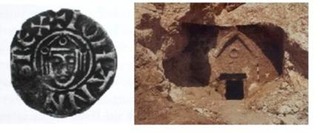
We can clearly see the chevron and circle emblem above the Talpiot tomb repeated above the face in the coin. The “twin pillars” familiar in Freemasonic ritual are also visible on the coin, a remnant of Solomon’s Temple described in the Hebrew Bible, in 1 Kings 7: “Thus he set up the pillars at the porch of the nave; and he set up the right pillar and named it Jachin, and he set up the left pillar and named it Boaz.” Apparently the chervron above a circle is a generic symbol for a temple, found on other coins minted in the Greco-Roman era. The emblem above the tomb appears to suggest that the tomb itself was considered a temple.
I suspect that the face on the coin is that of Christ and is, in fact, a reference to the Shroud of Turin which was in the custody of the Knights Templar and venerated as a “Head,” the long linen folded so that only the face was visible. In prior centuries the relic had been protected in a box with a glass front in Constantinople, an artifact mentioned in a sermon there in 944, but the box containing the face of Christ disappeared in 1204 and was believed stolen by “Frankish knights” during the sack of Constantinople by French Crusaders. The Knights of the Temple of Solomon who minted their coin in the 13th century obviously associated the image of the Man in the Shroud with the Talpiot tomb (containing the ossuaries of Jesus and his family), and their own connection with the twin pillars of Solomon’s Temple.
After the edict for their arrest was published in 1307, a number of Templar Knights are alleged to have made their way in ships to the western coast of Scotland, a country under interdict at the time, where they found refuge from the French King and Pope who had orchestrated their demise. Important archaeological evidence suggests that this story—often declared a “myth,”—is very likely true. At Kilmory Knap Chapel “Church of Mary”) we find an array of 13-15th c. tombstones, several of which depict a knight in armor carrying a sword, and some also with a sailing ship pictured above the figure. Here is an image of the rubblework stone ruins of Kilmory chapel.

And here is an array of the gravestones found near that chapel.
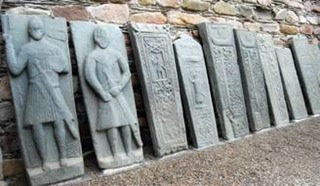
At Kilmartin (Church of Martin), about 9 miles north of Kilmory, we find gravestones with cravings of skull and crossed bones, the very relics associated with the contents of a 1st century Jewish bone-box. St. Martin is the patron saint of soldiers, so it would not be surprising to find Templar graves in the churchyard of “Kilmartin.”
The skull and crossed bones and long-blade sword are associated with Templar tombstones in France, as they are, I suspect, with those in Scotland as well. Here are several photos of tombstones at Kilmartin, Argyll in Scotland, similar to the ones displayed at Kilmory, nine kilometers away.
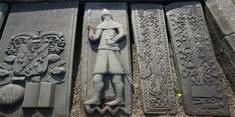
So where might this story lead us in our post-Easter wanderings?
The Templars in Jerusalem were undoubtedly aware of the Talpiot tomb with its ossuary of Jesus, along with Gnostic traditions that Jesus Christ was fully human—Rabbi, Master, and Friend—a “perfected human being,” founder of “The Way,” who gave His life for His friends as the Gospels assert, promising His followers eternal life with Him on the spiritual plane from which His Spirit continues to guide and succor us. The Templars repudiated the cross of Jesus because they refused to honor an instrument of torture. They venerated the Shroud of Turin as proof that Christ was resurrected on a spiritual plane, the “first born of many brothers.”
Heirs of these same Templars very likely brought their secret traditions to Scotland in the early 14th century, from whence their beliefs migrated into Freemasonry after several centuries of secrecy. Theirs was a time-honored legacy of freedom-fighters rejecting tyranny in any form, a legacy that eventually influenced the patriots and revolutionaries of the United States, many of whom were freemasons, who authored our foundational documents--the Declaration of Independence, the U. S. Constitution and the Bill of Rights. They were adamant in support of absolute religious freedom, freedom of speech, right to assemble and bear arms and other basic God-given rights that no ruler could deny them.
____________________________________________________________________
30 October 2012
Living Water, a Metaphor for Wisdom/Sophia
Early this month I had the opportunity to speak at an International Gnostic Congress in Fos do Iguaciu (Iguazu Falls), Brazil. My presentation was translated into six languages for the 1000 attendees many of whom did not speak English. I was humbled—and honored!—to share Mary Magdalene’s story at this amazing assembly on the 70th anniversary of my Baptism, feeling a sense of fulfillment that my “journey” had brought me to that moment in that place. Since a picture is worth a thousand words, I highlighted the heretical symbols imbedded in medieval paintings of Mary Magdalene using powerpoint slides and a red laser light. Many of the assembled participants were former Catholics from South American countries including Brazil, and from Spain, Austria, Germany and Scandinavia. Others were from various nations in Asia: Japan, Korea, Thailand, India and the Philippines. Many were well aware of Mary Magdalene from their Christian backgrounds, and some had read The DaVinci Code, but were not aware of my research and conclusion that Mary Magdalene is the “Lost Bride” of the Christian mythology, the “Beloved Complement” of the Christ. Some came to me in tears following the presentation to thank me for making the journey….not just to Brazil (7,000 miles each way from Seattle!)—but my spiritual journey from birth. We hugged and cried, celebrating the return of the Lady Magdalene into the mainstream of consciousness. I experienced an overwhelming joy and gratitude for being able to share my Magdalene revelations with these many enlightened “seekers” of the Way.
The morning after my presentation, two of my sponsors took me to see the magnificent Iguaciu Falls, an unofficial “8th Wonder of the World.” The site isn’t just one beautiful waterfall; it’s a horseshoe shaped ridge of many waterfalls cascading in several layers, rivers flowing out of the Northern jungles and pouring into the gorge below that forms the border between Argentina and Brazil. Sunlight forms rainbows in the spray from the falls—reminding us of the “harmonious union” of the irreconcilable opposites—fire and water. You can see pictures of the falls at these links:
http://www.travlang.com/blog/iguazu-falls-an-instance-of-majestic-natural-beauty/
http://nature.new7wonders.com/archives/wonder/iguaza-falls
“Living water”—springs and streams that move and flow—is used as a metaphor for God, and especially for the nourishing and comforting “Feminine” aspect of God, the Holy Spirit. I’m recalling quotations from the Judeo-Christian Scriptures, passages like this one: “Behold, I am doing something new; I am putting water in the desert for my chosen people to drink.” This was the passage my Baptist chaplain friend Ralph Benson received when he prayed about my Magdalene research in 1990 when I told him that I believed that one of the important secrets of Freemasons was that Jesus was fully human and married. When he asked for a second passage to support my theory of the “Sacred Marriage,” he was given Mark 14: the Anointing at Bethany by the woman with the alabaster jar. He was one of three Army chaplains at Fort Lewis, WA, who encouraged me to write a book about my research; the result was “The Woman with the Alabaster Jar” (written August, 1990, published 1993).
Here is a lovely quote from Psalm 36:9
“For with you is the fountain of life: In Your light we see light.”
And another (John 4:10)
“Jesus answered and said to her, "If you knew the gift of God, and who it is who says to you, `Give Me a drink,' you would have asked Him, and He would have given you living water."
From John 7: 38 "He who believes in Me, as the Scripture said, `From his innermost being will flow rivers of living water.' "
And another favorite:
"Thou shalt be like a watered garden, and like a spring of water whose waters fail not" (Isaiah 58:11).
A final Scripture mention of “living water” is found in the book of Revelation (Apocalypse), chapter 22, where, following the nuptials of the Lamb and his Holy Bride (the New Jerusalem), streams of living water flow from the throne of God, nourishing the Tree of Life, whose leaves are for the “healing of the nations.”
This image has nourished my spiritual life for decades, ever since my friend Mary Beben received in prayer at the Catholic Chapel at West Point a locution saying “It is time for the nuptials of the Lamb,” which she shared with our Emmanuel Community prayer group. The location of her locution was the church where I was baptized on Oct 4, 1942—the feast day of St. Francis of Assisi.
Over the years, we were made aware of Carl Jung’s insightful comment from Answer to Job. In effect, Jung insists that it is incongruous to try to imagine Jesus embracing a building—a church or community of people. We need to envision Jesus embracing a flesh and blood woman who represents the people—the ekklesia, the “Bride of Christ.” The woman who is thus envisioned is Mary Magdalene, the woman who, as the representative of her land and people, anointed Jesus “Messiah” at the banquet in Bethany, an action derived from the ancient rites of hieros gamos (sacred marriage) indigenous to the Middle East.
In reclaiming this “sacred union” at the heart of the Christian story we acknowledge and celebrate the “Nuptials of the Lamb and his Bride” causing “living waters” to flow through the streets of Jerusalem, nourishing the Tree of Life.
I’d like to close this article with one of my favorite quotes about “Sophia”—the Wisdom of God, Mirror of Divinity, from the aprocryphal Book of Sirach (Ecclesiastes):
“The first man never finished comprehending Wisdom,
nor will the last succeed in fathoming her.
For deeper than the sea are her thoughts; her counsels, than the great abyss.
Now I, like a rivulet from her stream, channeling the waters into a garden,
Said to myself, "I will water my plants, my flower bed I will drench";
And suddenly this rivulet of mine became a river,
then this stream of mine, a sea.
Thus do I send my teachings forth shining like the dawn,
to become known afar off.
Thus do I pour out instruction like prophecy
and bestow it on generations to come”
(Book of Sirach 24: 28-33)
Peace and well-being,
Margaret
* * * * * * *
Blog 8-22-12
Origins of the Tarot Trumps
I believe the original Tarot Trumps are a flash-card "catechism" for the story of the Grail family and the "heresy" of the marriage of Mary Magdalene and Jesus--as discussed in The Woman with the Alabaster Jar and later, in more depth, in Tarot Trumps and the Holy Grail: Great Secrets of the Middle Ages.
My “Alabaster Jar” book was cited as a significant source by Dan Brown in The Da Vinci Code and was later embellished in The Tarot Trumps and the Holy Grail (2000). The entire sequence of these early trump cards, where the fashions worn are from the 15th c Italian/French modes) tells the story of the "Grail family" and their allies, the Knights of the Temple, who were arrested, tortured and in some cases burned alive protecting the "great secret"/heresy of the Middle Ages. The cards are a “Midrash” of the promises made to the royal heirs of King David only if they proved faithful to God’s commandments.
When I first encountered tarot trumps in a book by Richard Cavendish, I was looking at line drawings from the deck long—but erroneously—dubbed the “Gringonneur/Charles VI). My eyes first lit on the “hermit” card and I said, off the top of my head, “I wonder what Peter the Hermit is doing here.” One would have to know enough European history to recognize Peter the Hermit, in order to make that association. I knew the drawing depicted “Peter the Hermit” because I read his name right off the card---where there is a gratuitous rock running up the right side. Every Christian child knows that Peter’s name means “rock.” Peter the Hermit was instrumental in preaching the 1st Crusade in the 1090’s, because he felt it was time to take Jerusalem back from the Saracens and place a “legitimate heir” on the throne of Jerusalem (in the person of Godfroi of Lorraine/Boulogne, a Europen nobleman of Merovingian descent.
My interpretation of the Tarot is securely based on Scripture and specifically the on promises in the Old Testament made to the descendants and heirs of King David. When traditional Tarot scholars look at the “hermit” card, they see a hermit. They call it an “archetype.”
What other interpreters have assumed to be general or “archetypal, I under-stand to be very specific and historical: Peter the Hermit, 11th century monk. It is not my purpose to provide a scholarly treatise on the opinions and interpretations of other scholars based on their opinions of the origins of Tarot. I bring my own knowledge of European history, art, and lore, including the medieval watermarks that hold so many clues to the symbols (like the “X’s” on the cherubs in the clouds above the “Lovers”—and the barren staves that support the Hanged Man—so enigmatic, unless one knows that the Inquisitors subjected the Knights Templar to heinous sexual tortures in an attempt to discover their “secrets” and “treasure”).
Turning to examine the "Gringonneur/Charles VI" trumps, believed by some to be the Estensi Deck, I was able to interpret each card in a specific historical context—11th-14th century Europe. The “Charioteer” is not driving a chariot. He’s riding atop a hearse, and he’s carrying a battle-axe and wearing the red felt hat of the Templar Order.
He is a Templar, returning from Jerusalem. The “Hanged Man” is the 13th card, a reminder that it was on Friday the 13th of October that the Templars were arrested by edict of the French king Philippe IV with the collaboration of Pope Clement V. Each card in turn embellishes the history of the Grail family and its friends. “Strength” holds the broken pillar “Boaz” in her arms, a reminder that the Temple in Jerusalem is in ruins and the bloodline of the Davidic heirs (descended from Boaz) is in foreign exile. Boaz means “strength” in Hebrew.
Based on my study of the 16 extant trumps of the "Gringonneur-Charles VI" deck, which I believe to be one of the earliest examples of Tarot trumps, the "stricken Tower" is an illustration of the lament of the heirs of the royal Davidic bloodline, a pasage from Psalm 89:
"How long, O Lord, will you hide your face from us?...
You have repudiated your promises to our ancestor David.
Our enemies ridicule us with scorn.
Our citadels are in ruins, our crowns are in the dust."
In this deck, the tower has blood pouring from its rocks—so interesting in light of the fact that Mary Magdalene's title if derived from the word "Magdala," meaning "Tower" in Aramaic.
Medieval legends say that the "Grail" (which appears in the card decks as the "cups/ chalices" suit) was lost because the unworthiness of its custodians. The promise that God made to David was that, if his descendants "walked in the way of the Lord," they would retain His favor and promises. Apparently they lost God's favor when they resorted to the "sword" and power politics to assert their kingship. The Prophet Zacharia provides the Lord’s message to Zorrobabel (the “Shoot”—heir of the Davidic bloodline): “Not by an army nor by might, but by my Spirit, says the Lord of hosts.”
I am not an expert on “tarot.” I’ve not studied other decks, theories, and histories in any great depth. My credentials are in the field of medieval studies: culture, art, literature, history and Holy Scripture. By way of background, I graduated from an American high school (1959) in Nürnberg, Germany, and spent my first year of college (’60) in Münich. later attending the Christian Albrechts University in Kiel, Germany, on a Fulbright student fellowship (’63-64). I spent nearly four of my “formative years” in Europe visiting medieval towns and churches, art museums, castles, and historical sites.
I was—for an American—unusually “steeped” in European culture and history from the time I was 15 and have pursued these passions ever since. I studied Latin and German in high school, French and more German in college, majoring in Comparative Literature and minoring in European History. I experienced the 1960 Passion Play at Oberammergau (1960), Easter in Paris, autumn ’63 in Heidelberg, Christmas in Bamberg. Following college graduation (’63) I traveled all over Europe, including a 3-month “tour” using Europe on $5 a Day as a guide.
In one of my graduate classes at U of MD (where I studied and taught German for 4 years—1964-68—while I was working on my MA and PhD course work in Comparative Literature, we read the “Parzifal” epic of Wolfram von Eschenbach (13th c) in the original “Old High German.” This is probably the earliest written mention of the “Grail family” connecting them with the “Templeis” (an “inner circle” of the Knights of the Temple or “Templar” brotherhood) who von Eschenbach claims were the “guardians of the Grail Family.”
Many “Grail” legends are even older than the “Parzifal,” whose hero is the prototype of the “Fool” in the tarot trumps series. Parzifal stumbles into the truth about the “Grail” through a “journey” relying on a series of synchroni-cities and chance encounters—the embodiment of the principle of “intuitive guidance” inherent in tarot “divination.”
Obviously I can’t itemize here all the allusions and associations of the “Grail” lore and traditions. It’s a case of looking at the symbols of the “great secrets” and the “underground stream” of Western civilization and decoding them. My most important tools for interpreting the meanings of the trump cards were Scripture and medieval watermarks hidden in the Bibles of the Albigensian heretics (Cathars, Waldensians and others)—whose “faith forgotten” was so ruthlessly rooted out during the Albigensian Crusade (1209-1250) by the “Holy Office” of the Inquisition.
In 1209 the town of Béziers was besieged by the troops of the French King and the Vatican. The townspeople fled to the church for sanctuary, and on the July 22, the official Catholic feast day of Mary Magdalene, the building was burned down over their heads. The chronicler Pier vaux de Cherney, writing in 1213, states that this was by divine providence, apparently to punish the heretics for their slanderous assertion that Jesus and Mary Magdalene were lovers. This belief survived among Freemasons (whose brotherhood is derived from Templar traditions) and from there, at the behest of Joseph Smith, made its way into the doctrines of the Church of Latter Day Saints (Mormons) in the mid -19th century. A book by Dr. William E. Phipps called Was Jesus Married, first published in the 1970, examines the idea of Jesus’ marriage from the point of view of 1st century Judaism, a time and place where marriage was a cultural imperative.
Baigent, Lincoln and Leigh. the authors of Holy Blood, Holy Grail, (1982) did not invent this heresy It is rooted in European history. Whether it is “true” or not is another question, but the heresy itself existed and is well attested, hidden under a veil of symbols. I personally believe that Arthur E. Waite was aware of it at least to some degree, but preferred to keep it “hidden” and deliberately obfuscated it in his tarot book. In his book, “The Hidden Church of the Holy Grail,” Waite shows some inkling on his part of a church with a hereditary priesthood going directly back to the origins of Christianity and to Joseph of Arimathea, the “guardian of the Grail.” Waite was probably too Catholic to ever objectively consider that Jesus might have been married and that the hereditary connections of the “Grail” priesthood he intuited might have roots in the “bloodline of Christ.” The veil had not yet been lifted on Mary Magdalene, the Bride and Beloved.
In the West, Mary Magdalene was the pre-eminent witness to Christian origins. I’ve spent whole chapters in my 2005 book Mary Magdalene, Bride in Exile” developing her role as “Bride” and “Beloved” based on the canonical Gospels. I believe that “the Magdalene” is a title given to Mary of Bethany because of her status as wife and widow of the “Sacrificed King,” derived from an ancient prophecy in the Hebrew Bible: Micah 4: 8-11. The prophecy begins, “As for you, O Magdal-eder-- Watchtower of the Flock”—to you dominion will be restored, to the Daughter of Sion. Why are you crying? Have you no king? Has your counselor (teacher) perished, that you cry aloud like a woman in labor?...” The passage prophesies her foreign exile and defamation: “Nations will gather against you, they will profane you (call you unclean).” Where has any one found a more succinct version of the life and fate of Mary Magdalene?
Since Mary Magdalene is very prominent in the Gospels, especially the Gospel of John where she goes alone to the tomb on Easter morning and is sent to tell the brothers of Jesus that he has risen, it is amazing that she is never mentioned at all in any of the letters of Paul or in the Book of Acts of the Apostles. Clearly she was not there. The most likely excuse for her absence is that she was taken by friends or family (Joseph of Arimathea comes to mind, since he is claimed to have been the “custodian of the Grail”) to a place of safety, probably in foreign exile (as prophesied in the Book of Micah 4: 10. The only piece in any of my books that is actually fiction is the 20- page “novella” at the beginning of “Alabaster Jar.” There is no proof that Joseph of Arimathea persuaded Mary of Bethany, called “the Magdalene,” to go into exile, but it makes sense, especially if she was pregnant. She would have been considered a “national treasure” and her unborn child, the hope of Israel. Since Paul is known to have persecuted the Christians (before becoming one!), he would have been the very last person the family would have told where they had taken her. The other Desposynoi remained in Palestine, but powerful medieval tradition places Mary Magdalene in Gaul, arriving there in c. 42 with her family (Lazarus, Martha, Maria Jacobi, Maria Salomé) in a boat with no oars, and bringing with them the “Holy Grail.” Oh, yes. And there was a child on the boat. She was allegedly the maidservant of her relatives. But her name was Sara, which means “Princess” in Hebrew.
The “flowering staff” is a very ancient symbol for the Davidic bloodline, which springs from the “root of Jesse” (the father of David). In the book of the Hebrew prophet Haggai, the Davidic king is Zorrobabel, called “Shoot” (Branch or “Sprout”). In the War Scroll found among the Dead Sea Scrolls, the expected Messiah is called the “Scepter”—a title derived from Genesis, where God tells Judah, that he will be the prince because he is the “strongest of all his brothers” that he is a “lion’s cub” and that the “scepter will not depart from Judah.” In Christian churches worldwide, Joseph, the husband of Mary, is shown holding a flowering staff –because he is the “custodian of the Davidic bloodline.” In our card decks, the “flowering staff” or “scepter” becomes the emblem for the suit of clubs.
This same symbol is attributed to Joseph of Arimathea who planted his hawthorn staff at Glastonbury where it allegedly sprouted and grew into the “holy thorn”—visible still on a hillside not far from the famed “Chalice well.” There is a strong association of the “flowering staff” with the “Grail Family” and its Davidic ancestry. The “motif” survives in paintings that depict royal scepters with a “fleur-de-lis” sprouting at the top—indicating “divine right of kings”—based on their lineage.
Now view the picture of Mary Magdalene by Jan de Scorel here:
Mary Magdalene is dressed in green (symbol of fertility!)—not her usual red and white or gold brocade. She has gold brocade (associated with the Bride of the Messianic King –see Psalm 45) in her lap and “leafing” or “flowering” above her head is a single branch of a dead stump. She has X’s running up her left arm. For those who have read my books, this is motif should be familiar: the “X” was one of the pre-eminent symbols of the “alternative” or “hidden” church of those who believed that Mary was the wife of Jesus and is often found in paintings of her. For the Europeans of the 15th century, those who created unicorn tapestries and tarot trumps, the claims of the hidden Grail family were alive and well, the “Vine”—God’s cherished plant from the vineyard of Judah--of which they themselves were the extant branches, progeny of the “root” of Jesse and the Davidic bloodline of which Jesus is claimed to be descended.
* * *
Blog 7-21-12
Magdal-eder--"the Tower of the Flock"
Migdol, the village widely accepted as Mary Magdalene’s home town situated on Sea of Galilee just north of Tiberias, was called by a different name in Biblical times. According to Flavius Josephus, the first-century Jewish author of The Jewish War, describing the Jewish Revolt against the Romans (66-73 A.D., the town now called Migdol or Mejdol (Hebrew for “tower”) was known in his day as Taricheae. In the introduction of his book, Josephus states that he wrote the original draft of his book about the Jewish revolt in the early 70’s in Aramaic, his native tongue, for speakers of Aramaic. Had the town been called “Magdala” in his time, Josephus would most likely have mentioned that name rather than the Greek “Taricheae” in his history.
Evidence shows that it was called by the Greek name Taricheae in Roman records dating from as early as 43 B.C. Almost a hundred years later, official Roman records from A.D. 53 again mention Taricheae, stating that territory including Taricheae and a number of other neighboring cities were ceded by Rome to the Jewish King Agrippa II. It is well established that Romans called the city by its Greek name for nearly a century and for at least two decades after the crucifixion of Jesus. In the decade before the city was destroyed by the Romans and its residents slaughtered, the city of nearly 40,000 residents sported a hippodrome where the Hellenized populace enjoyed horse and chariot races. Flavius Josephus visited Taricheae on several occasions and was present at its capture and destruction of Taricheae by the Roman general Titus Vespasian in A.D. 67, but makes no mention of the town’s Aramaic name, if it had one, in any of his writings.
This passage from Josephus becomes very important in our quest for the meaning of Mary Magdalene’s epithet. The title of the tenth chapter in Book III of The Jewish War names both the city Taricheae and the country of Gennesareth. In the opening lines of the chapter, Josephus mentions that people of the region call the lake “Gennesareth” (its Aramaic name). Since he was writing his original draft in Aramaic, this seems logical enough. But logic says also that he could have stated here that the local people call Taricheae “Magdala” if that were in fact the case. He does not. He calls the city by its Greek name and the Lake by its Aramaic name, which, as we know from John’s Gospel, the Romans called the Sea of Tiberias (John 21:1). Josephus, writing in about 70 CE gives no hint that the Hellenized Galilean city was called “Magdala.” I am convinced that his Aramaic audience as well as the Roman all called the town by its Greek name, which had been in use for more than a century and probably longer.
The first-century Geography of Palestine by Strabo (Book XVI, 2, 45) mentions that Taricheae is noted for salted fish. Strabo lived from 46 B.C.—A.D. 20, a period that spanned what would have been a likely birthdate for Mary Magdalene, but the town she is now thought to have been born in was called Taricheae at the time. Pliny (Natural History, V, 71) and Suetonius (Life of Two Caesars) also mention Taricheae in writing. All available written evidence from Biblical times insists that the people traveling, visiting, living and campaigning in Palestine for a period of almost two hundred years called the town Taricheae.
The earliest evidence that supports the name “Magdala” for this town on the shores of the Sea of Galilee is the Jewish Talmud, a 4th century compilation of Jewish oral traditions. There is considerable confusion from various texts of the Talmud about the correct location and identity of the town “Magdala/Migdol” because several different names are given and there were apparently two or possibly evem three towns discussed: Mejdel, Magdal-Geder, Migdol Nunayah, and Magdala Sebayah (or Migdol Sebayah). The Talmud Ta’anit says that “Magdala” was wealthy and immoral, destroyed for “prostitution.” (Ta’anit 4, 69c). This allegation may have been symbolic rather than literal, since the town Taricheae was long characterized as “Hellenized,” meaning that it had adopted Greek life-style and mores, “chasing after false gods,” idolatry often characterized in Hebrew prophecy as “prostitution.”
How interesting that later Christians ascribed to the Mary called “Magdalene” the same allegations: wealth, immorality and “prostitution” ascribed to “Magdala,” a town the Talmud claims was destroyed for immorality. Because of the root word of the title “the Magdalene,” the idea became entrenched that this very town in Galilee must be the birthplace of Mary, the companion of the Lord. It seemed to them to fit so well with the sinful woman who anointed Jesus in Luke 7:37-50 and a few lines later, in Luke 8:2 was “called Magdalene” and healed of seven demons. The conflation of the town of ill repute, the anointing woman forgiven for her sins, and “the Magdalene” began here— even before John wrote his gospel in which he attempted to correct the record by identifying the woman who anointed Jesus "and dried his feet with her hair" as the sister of Lazarus—a woman from Bethany (John 11:2 and 12:3-5).
Piecing together the evidence of the 4th-century Talmud, the village was given an Aramaic name Magdala Nunayah after the defeat of Taricheae and the slaughter of its citizens in 67 CE.” The strongest reason for the “standard interpretation” parroted for centuries, that Mary Magdalene was from a town called “Magdala,” seems to be derived from the belief that the town existed, that it is mentioned in Scripture, and that Jesus visited it. If the town of Magdala did not exist by that name, and if it was only later called Magdala by Jewish sources, then it becomes very unlikely that it was the birthplace of the “Magdalene.” Zealous Christians eager to discover the meaning of the distinctive title “the Magdalene” may have searched for a town with a similar root word, apparently fixing their attention on the site of Magdala Nunuyah allegedly destroyed for its "prostitution," and rationalizing the restored town “Magdala” or Mejdal as the hometown of Mary Magdalene.
I sesnse something very fishy about this connection of Mary with “the Tower of the Fishermen.” Encountering the Aramaic name for the town, Christians who called Jesus the “Fish” (Ixthys) presumably concluded that it was the perfect and most suitable birthplace for Mary because of its Aramaic meaning, so the tradition was born that, for the same reason, appealed to later generations and was perpetuated. Modern day visitors still swarm to this site on the Sea of Galilee and muse there about the sinful life of Mary Magdalene, which, as is now recognized, was an unsubstantiated slander. How could this town have been the birthplace of Mary called “the Magdalene” whom the early Church fathers—Tertullian, Ambrose, Jerome, Augustine, Bernard and Thomas Aquinas among them—in their writings universally assume to have been the sister of Lazarus from the town of Bethany?
Medieval chroniclers of the lives of the saints, duped by the Church-fostered tradition of her bad reputation, often state that Mary Magdalene’s family owned property in both towns, Bethany and Magdala, thinking that is the most logical solution for her apparently dual citizenship, and attempting to reconcile the accounts of the anointing in Luke and Mark/John. Rabanus Maurus, archbishop of Mainz in the ninth century, is the supposed author of one notable Latin text that makes that assumption—The Life of Rabanus—a copy of which dates from about 1400 and is housed in the Magdalen College Library at Oxford.16 Rabanus, like all medieval chroniclers, assumes that Mary was the sister of Martha and Lazarus and tells the story of the siblings and their voyage to Gaul.
The whole rationale woven around the town of Magdala is, in my opinion, a very "fishy" red herring cover story designed to place Mary Magdalene (the exalted and great one!) as far away as possible from Bethany and the Mount of Olives (of supreme prophetic importance) and to deliberately associate her with a town of evil repute. The Roman Catholic Church continued to maintain the connection of Magdalene with the siblings in Bethany when post-Reformation Bible scholarship, conforming to the Eastern Orthodox tradition, began to separate the two Marys. Only in 1969, in an attempt (misguided in my view) to adopt a more ecumenical position on the role, did the Catholic church separate the two Marys—Magdalene and the sister of Lazarus—in their official liturgies.
I am personally convinced that the earliest Christians were right in believing that Mary Magdalene and Mary of Bethany were the same Mary—the Bride and Beloved of the Messiah/King of the Jewish nation. There is another rationale that accounts for Mary’s unusual epithet, a rationale that has nothing whatever to do with the town called Magdala, allegedly destroyed for its sins like Sodom and Gomorrah. This rationale proclaims a potent prophecy of her role as Bride of the sacrificed King—a rationale for centuries overlooked because Scripture exegetes have never recognized Mary Magdalene as the forgotten Bride of the Christian mythology. “It can’t be true,” they claim; “it’s not what we teach!”
Among the sacred texts of the Hebrew Bible, deep in the book of the prophet Micah is an obscure passage addressing the bereaved “Bride” representing the people of Jerusalem. She is called “Daughter of Sion,” and referred to symbolically as the Magdal-eder—the “Watchtower” or “Stronghold” of the Flock—and she is seen mourning the death of her “counselor” (rabbi? Or Lord?) and King:
“As for you, O Magdal-eder,
Watchtower of the Flock,
Stronghold of the Daughter of Sion,
unto you shall the former dominion be restored,
the kingdom of daughter Jerusalem.
Now why are you crying?
Have you no king? Has your counselor perished,
that you are seized with pains like a woman in labor? . . .
For now shall you go forth from the city
And dwell in the open fields.
To Babylon shall you go,
and from there you shall be rescued . . .
Now also many nations are gathered against you, that say,
‘Let her be declared unclean...’”
(Micah 4:8-11.
In the Gospels, Jesus is the “Good Shepherd.” Might not his wife have been understood by his followers to represent the “Tower of the Flock” addressed in this ancient scripture? Micah’s prophecy, written in the eighth century BCE, presents the exact scenario that became Mary Magdalene’s own story, closely linked with the exile, the Diaspora, of her people. The prophet Micah describes the desolated royal Bride crying over her deceased Bridegroom, the Messianic King. He prophesies her foreign exile, —and her eventual return!—but he also confirms her denigrated status: “Let her be called ‘unclean’.” One translation of this line calls her “defiled” and another uses “profaned” How can Scripture scholars have failed for two millennia to recognize in this prophetic passage “the Magdalene” in her role as the “Daughter of Sion,”—the defamed and denigrated Bride of Jesus forced into foreign exile? Why does she cry? Has she no king? Has her “rabboni”—her Master and teacher or “counselor” perished?
Only a few lines further on in Micah’s prophecy we find a prophetic passage used by early Christian exegetes to affirm the claim that the Davidic Messiah would surely be born in Bethlehem (Micah 5:1). The author of Matthew’s Gospel included that prophecy from Micah in his own text (Matt. 2:6) showing how Jesus fulfilled the words of the prophet. I believe this somewhat earlier passage of Micah 4:8-11 describing the desolated bride, the “Daughter of Sion,” was used in a similar way by the earliest Christians as a prophecy about the bereaved bride of the Christian story, who was already safely hidden away in foreign exile, probably in Gaul, by the time any of the Gospels were committed to papyrus. The very earliest strata of Christians—the family members and friends of Jesus persecuted by Saul and his peers in the Jerusalem Church—knew the words of their prophets and deliberately seized upon this passage as prophetic of the fate of the wife of their crucified Messiah, just as they seized on passages from Isaiah and the Psalmist that seemed to prophesy events in the life of Jesus. On this basis, they coined the honorific title h Magdalhnh for Mary, tantamount to calling her “the Great” or “the Magnificent.” Clearly they couldn’t explicitly call her the “wife of Jesus” without increasing the risk that the Roman authorities might seek to destroy her as they did so many others of the Desposyni, the blood relatives of Jesus and his brother James.
The prophetic connection of Mary Magdalene with the bereaved “Daughter of Sion” is too powerful to be ignored. In Micah 4:9, as always, the bereaved Bride is crying. It is the ubiquitous and predictable role of the Bride to cry for the deceased Beloved. Ishtar mourns Tammuz in pagan mythology of the Babylonians, as Isis cries over Osiris and Venus for Adonis. In John’s Gospel, Mary Magdalene stands weeping outside at the garden tomb. As she weeps, she stoops down and looks into the sepulcher. Two men seated in the tomb ask her why she is crying, and a short time later, when she encounters the risen Lord, whom she at first mistakes for the gardener, he too asks her why she is crying. This lament of the bride over the sacrificed bridegroom is the duty and prerogative of the Sister-Bride from the ancient liturgies of the sacrificed king, found in the cults of Tammuz, Osiris, Ba’al, Attis, and Adonis and other tortured and sacrificed pagan gods where the Bride mourns the death her mutilated mate—repeated in Micah 4 where the Daughter of Sion mourns her perished king and counselor.
And in fact, tears are one of the distinguishing features of Mary Magdalene. In John’s Gospel, she cries over the death of her brother Lazarus, moving Jesus with her tears: “. . . he groaned in spirit and was troubled” (John 11:33). She later cries over the feet of Jesus and wipes her tears with her own hair (John 12:3). She cries for her King and “Counselor” (as in Micah 4:8-11) again in the Gospel narrative (John 20:11). And she cries again in the Gnostic Gospel of Mary, when Peter rejects her testimony about her vision of the Risen Christ. The sorrowful “Madonna” who cries is not the mother of Jesus, but his Bride. At the Basilica of the Madeleine at Vezelay, an over-sized statue of Mary Magdalene stands in a side chapel—majestic, yet graceful—cradling the Grail chalice against her abdomen, as a woman sometimes cradles her unborn child. She has a tear on her cheek, a poignant reminder of her role as the bereaved Bride. At some point in my search I began to wonder if the statues of the Madonna who cries in so many shrines and churches around the world were really Magdalene—whose tears are a such a ubiquitous and distinctive characteristic of her iconography. The English word “maudlin” is derived from her name and means overly sentimental or emotional. To the extent that the Madonna images represent the feminine face of God, and its manifestation in the feminine half of creation, tears are hers—emblematic of compassion, an ubiquitous attribute of the “Sacred Feminine.”
'In Memory of Her"---- 22 July 2012
Blog 5-31-12
Denial of the Bride
The “San Andreas Fault,”—the design flaw that has plagued institutional Christianity since the second century—is its systemic denial of the feminine as partner. One important understanding that surfaced during Vatican II, was the idea that the Bishops should listen to the people, because the Spirit of God rests in the people.. This idea is expressed in Sirach 24, where Sophia finds her dwelling place in the people.
In light of the Vatican’s current attempt to assert its control over the women religious in the USA, I want to publish here revelations received in 1980 when Mt. St. Helens’ erupted on several key dates on the Roman Catholic calendar. My “Emmanuel” community had been shown that we were to interpret news events in light of the calendar which would help us to understand important developments with regard to the church.
The eruptions of Mount Saint Helens' in 1980 were hugely prophetic: the mountain named for the Emperor Constantine's mother blew up on Pope John Paul's 60th birthday (May 18) and again on the following Sunday, May 25th, the feast of Pentecost.
On noticing these auspicious (ominous?) dates, I immediately associated the volcano with the "Institutional Church." The "fire mountain" bearing her St. Helena's name imploded causing incredible devastation. Spirit Lake spilled its waters down into the coastland below. I knew the place well—my husband I spent a delightful fishing vacation there in 1973. Harry Truman, the proprietor of the fishing camp, visited with us over meals cooked by his wife. When warned about the impending implosion of the mountain, Mr. Truman elected to die on the mountain because his wife was already buried there.
The Scripture passage I received when I spontaneously opened my Bible while praying over the volcano's eruption was electrifying:
"Beware. I am against you, destroying mountain. I will stretch forth my hand against you, roll you down over the cliffs and make of you a burnt mountain." (Jer. 51:25). I was convinced that the passage was referring not just to the mountain, but t0 the Church.
A couple of months later, another explosion of the Mt St Helen's occurred on 22 July 1980--the Feast of Mary Magdalene--which in that year fell on the "9th of Av,” the day when Jews go to the Western Wall to mourn the destruction of their Temple not once—but on two occasions, 587 BCE and AD 70. My friend Mary Beben was at the Wailing Wall on that day and had requested our Emmanuel prayer group to offer a novena leading up to the 9th of Av and to be with her in prayer on that date, mourning for the Temple that has not been rebuilt.
The "synchronicities" and connections of these dates were, I believe, hugely prophetic. At the time, my friends and I had been told to record dates of events and check them against the Church calendar. We all thought that the prophesied implosion of the Church had to do with the bank scandals and the cover up of the alleged murder of John Paul I (another 'story rarely told'). We had no idea of the other internal problems brewing.
Here's what the erupting volcano revealed when we prayed about it:
The implosion would come from within the Church
It would become obvious during the "watch" of John Paul II
It would cause an outpouring of the waters of the Holy Spirit to be poured out into the earth (Spirit Lake poured down the mountain, into the sea).
The nature of Jesus as “fully human” ("true man") was an important issue
The "Temple" would be destroyed because of the denial of "Mary Magdalene" as partner of Jesus and of all she represents as "Bride" including relatedness to the earth, kinship of all people, the voices and gifts of women to the "body of Christ."
The model of "Sacred Union" was broken in the cradle of the Church--waiting to be restored.
The “revelation” of Mt. St. Helens’ is discussed in chapter 3 of my book, The Goddess in the Gospels.
I find it comforting to believe that the Spirit orchestrated the eruptions of Mt. St. Helens to coincide with those dates to let us know that “implosion” of the Church in our time is part of God's plan for a hierarchical institution grown rigid and arrogant in its refusal to hear the voices of the people.
* * * * * *
04-05-12
Blog
Bride of the Easter Mysteries
In the Christian Gospels, the anointing of Jesus by the woman with the Alabaster occurred several days before the Passover...John's Gospel says "six days before the Passover" and Mark says "two days before." Matthew places the event during Holy Week (copying Mark nearly verbatim) and Luke takes the whole scenario away from Bethany and places it early in the ministry of Jesus in some unnamed town in Galilee, calling the woman a "sinner." Only John names the woman who anointed Jesus: Mary, the sister of Martha and Lazarus of Bethany, but he borrows a significant detail from Luke: the woman "wiped her tears from his feet with her hair." In any case, the event did not occur on "Holy Thursday" (Passover) but rather, a few days earlier. The Catholic Church celebrates the "Feast of the Holy Chrism" on the Tuesday before Good Friday (Mark's "two days before Passover").... Jesus admonished his disciples to tell and retell the story of the anointing "in memory of her."
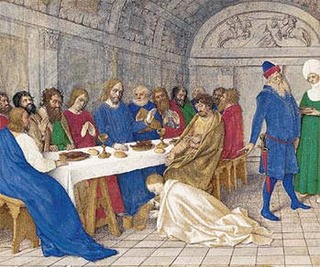
From "Heures d'Etienne Chevalier" illumination
by Jean Fouquet c. 1452-1460
Those who claim that Mary’s most significant role was as “Apostle to the apostles” miss the importance of the connection of the Passion story with the "sacred marriage" and sacrificed king mythologies of the ancient world. The whole passion story (IMO) begins with the anointing of Jesus by a woman--a royal "Bride" who represents her land and people, the "assembly" (Greek "ekklesia") as Bride of the Sacred King. Together they are reenacting the ancient rites of "hieros gamos" (sacred marriage) which celebrates the eternal return of the Life Force in the springtime in the northern hemisphere. The Bride anoints the King at the banquet, reminiscent of the scenario in the Song of Songs. The royal Bride and Bridegroom consummate their marriage, and then, later in the liturgical sequence of these ancient (pagan) rites, the King is arrested, tortured, mutilated, executed /sacrificed and laid in a tomb. After a period, usually on the third day, the Bride and her maidens return to the tomb to mourn the deceased King and are overjoyed to find him resurrected in the garden.
Haven't we heard this story before? It's a very similar story in the myths of other god/goddess couples in the ancient Near East (Tammuz /Ishtar, Adonis/Aphrodite, Attis/Cybele, Isis/Osiris, Astarte/Baal. Easter is named for “Oestare,” a pagan goddess derivative of Ishtar and Astarte. This ancient rite of the Bride mourning the deceased king also provides the scenario presented in Micah 4:8-11, the prophetic passage addressed to the "Magdal-eder," that sums up the story of Mary Magdalene in four short lines: "Why are you crying? Have you no King."
How can we fail to notice the "Bride of the Easter Mysteries"? It was the role of the royal Bride to anoint her husband and to meet him resurrected in the garden.
Some would have us call Mary Magdalene by the title coined for her by Hippolytus of Rome (150-235): "Apostle to the Apostles."
Won't that make her about equal to Peter? We know the Magdalene was requested to carry the Good News of the resurrection to the other apostles--but is that really her most important role? Her greatest claim to fame?
Claiming the important role of Apostle for Mary Magdalene may give women in the Church a voice and some added authority within its walls----but it will never heal the desert or make the flowers bloom! The "sacred marriage/hieros gamos" was never about "Mrs. Jesus." It's about the sacred partnership of "Logos" and "Sophia" at the very heart of the Christian story—a hieros gamos partnership that was to have been our birthright---sadly broken in the cradle of Christianity. It can only be restored when Mary Magdalene is restored to her proper role as the "Divine Complement" of Christ. This story is not about sex in the first century; it's about imaging the Divine as intimate partners in a "sacred symbiosis"--creating a mandala for balance: the "Cosmic Dance."
We celebrate the "Sacred Reunion" of the Beloveds in the garden on Easter morning-- the "eternal return" of the Life Force.
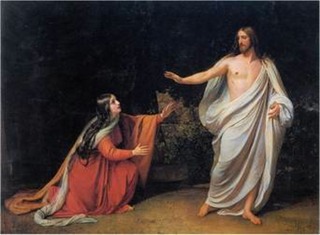
Noli me tangere ("Don't touch me")
Alexander Ivanov (1806-1858)
Lilium Regis
by Francis Thompson (1910)
O Lily of the King! low lies thy silver wing,
And long has been the hour of thine unqueening;
And thy scent of Paradise on the night-wind spills its sighs,
Nor any take the secrets of its meaning.
O Lily of the King! I speak a heavy thing,
O patience, most sorrowful of daughters!
Lo, the hour is at hand for the troubling of the land,
And red shall be the breaking of the waters.
Sit fast upon thy stalk, when the blast shall with thee talk,
With the mercies of the king for thine awning;
And the just understand that thine hour is at hand,
thine hour at hand with power in the dawning.
When the nations lie in blood, and their kings a broken brood,
Look up, O most sorrowful of daughters!
Lift up thy head and hark what sounds are in the dark,
For His feet are coming to thee on the waters!
O Lily of the King! I shall not see, that sing,
I shall not see the hour of thy queening!
But my song shall see, and wake,
like a flower that dawn-winds shake,
and sigh with joy the odours of its meaning.
O Lily of the King, remember then the timing
that this dead mouth sang; and thy daughters,
as they dance before His way, sing there on the Day,
what I sang when the Night was on the waters!
* * * * *
03-04-12
Saint Barbara and Mary Magdalene
Years ago I became convinced that the Saint we know as "Barbara," patroness of military engineers, artillerymen and fire-fighters, is actually a cover-story for Mary Magdalene.
Here is a 15th century rendering of St. Barbara and Mary Magdalene placed side by side by a Rhenish Master. "Barbara" wears the crown of martyrdom and holds both a chalice and tower. Magdalene is diminutive, eyes cast down, bearer of the alabaster ointment jar.
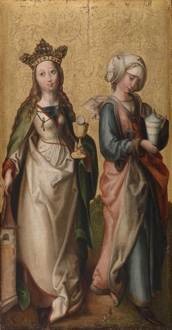
In 1969 the Vatican quietly declared St. Barbara "spurious" and deleted her feast day from the official Church calendar, but because they somehow failed to tell the US military units around the world, these regiments still celebrate St. Barbara's feast day 4 December at a formal "Artillery Ball."
The medieval legend of Saint Barbara is bizarre. She was the daughter, so the story is told, of a 3rd century Roman official in Syria. When he discovered that "Barbara" wanted to become a Christian, her father locked her up in a tower, hoping to solve the problem. But she let down her hair from the window of her prison cell so that her priest/mentor could climb up to her tower to instruct her in the Christian faith and bring her the Eucharist.
When her father discovered this outrage, he had his daughter beheaded, and then, on the way home from her execution, he was struck by lightning and electrocuted! We don't have to wonder why the Catholic hierarchy chose to erase Saint Barbara from its calendar!
The iconography of Barbara arrested my attention. She is invariably associated with a tower; she has fabulous long hair, a crown, and often a chalice. Here is a typical rendering of St. Barbara whose name means "foreign woman."
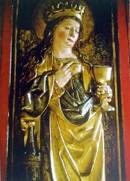
Below is an 11th century wall painting found in St. Edmundsbury in Hessett, Suffolk (England).
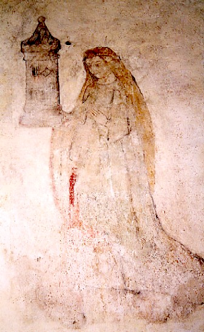
On what grounds could an art expert insist that this image is St. Barbara? Merely because she holds a tower, she is automatically assuemed to be that saint now fallen into disrepute because her story is too similar to that of Rapunzel, the maiden of the tower in a European fairytale. But there is another "Lady of the Tower" long over-looked , one whose icons inlcude beautiful long tresses, often red, and a chalice or "sacred vessel." That Lady is Mary Magdalene, whose title is derived from "Magdal," a Aramaic/Hebew root word meaning "tower" or "fortress."
Mary Magdsalene is universally associated with the alabaster jar of fragrant ointment, often included in any artistic image of her. The Song of Solomon (Canticle) from the Hebrew Bible speaks of the "nard" of the bride whose fragrance wafts around her Bridegroom at the banqueting table, a scenario repeated in the Gospel of John (12:3) when Mary anoints Jesus at the banquet and dries her tears from his feet with her hair: "and the fragrance filled the house." The Song of Songs states, " "... the King is captivated by your tresses" (SoS 7:5) and
"How beautiful is your love, my sister, my bride!
How much better is your love than wine,
And the fragrance of your oils
Than all kinds of spices! (SoS 4:10)
But the association of Mary Magdalene with the chalice is also very old. Her legends include the claim that fleeing into foreign exile, she brought the "Holy Grail" to France.
Below is a 13th c. rendering of Mary Magdalene from the Ekeby Kyrkeo on the Swedish Island of Gotland in the Baltic Sea. She is holding a chalice under the lance wound in the side of Jesus on the cross, a literal interpretation of her role as bearer of the "Sangraal" translated as the "Holy Grail" in later legends.
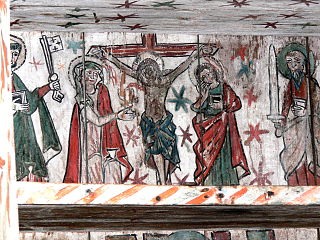
It is interesting to note that many of the 100 medieval churches on this island were built by Knights Templar who had a significant presence there. These Knights were the reputed "Guardians of the Grail family"--and presumably its secrets--during the Middle Ages. These secrets included the survival of descendants of Jesus and Mary Magdalene, the bloodline of the "sang real" (blood royal) of Davidic lineage. In the Book of Revelation 5:5 Jesus is called "Lion of Judah," an epithet reserved for princes of Judea. As his wife, Mary would have been the "bearer" of the blood royal.
I believe that Saint Barbara is a case of mistaken identity and that the woman with the long curls who held the tower in a early artistic rendering was meant to have been Mary Magdalene. Because uneducated observers did not know the Hebrew root of Magdalene meant "tower," someone made up a fabulous legend--the story of "St. Barbara"--to explain the iconography of the "Lady with the Tower," including extravagant details that excited the pious but could not survive modern scrutiny.
The two paintings below illustrate another case of mistaken identi-fication of Mary Magdalene with St. Barbara:
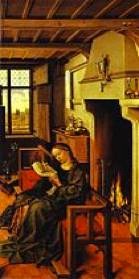
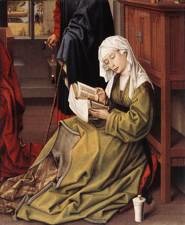
The painting on the left is "St. Barbara" (Werl Triptych 1438) attributed to Robert Campin, while the image on the right is "St. Mary Magdalene Readng" (1435-8) by Rogier van der Weyden.
These women in medieval dress are both seated in the exact same position. Each is reading a book, making her an embodiment of "Sophia," Goddess of Wisdom. Each wears a green robe (symbol of fertility) drawn up to reveal a gold brocade underskirt, the iconic wedding gown of the messianic Bride: "All glorious is the princess as she enters. Her raiment is threaded with spun gold. In embroidered golden apparel she is brought in to the King" (Psalm 45: 14-15).
Each woman has a vessel of ointment; St Barbara's glass vessel is on a shelf on the right, just above the fireplace mantle. The only possible reason for claiming that the woman on the left is St. Barbara is the tower barely visible from the window. Without that element of landscape, the long curls of the saint and the jar of oil would ensure the painting would be acknowledged as an image of Mary Magdalene--glorious long hair and an ointment vessel are her distinguishing icons.
The altar triptych below clearly depicts Mary Magdalene holding her tower, flanked by scenes from her life, the anointing of Jesus at the banquet (John 12) and the encounter with the resurrected Jesus at the tomb on Easter morning (John 20). Despite the tower, no one would dream of suggesting that this altar is dedicated to St. Barbara! It is most assuredly Mary Magdalene, holding the "Magdal" that is the source of her epithet "the Magdalene."
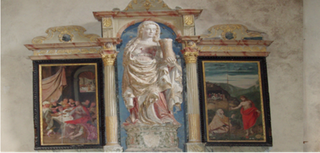
Perhaps the "missing link" in this short discussion is the early 14th century image of a red-robed Mary Magdalene by Segna di Bonaventura (c. 1320) in which she holds a tower-shaped jar. We know the painting is Mary Magdalene because the inscription across the bottom says so!
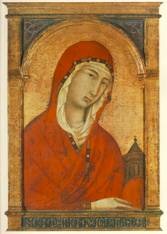
* * * *
02-13-12
Mary Magdalene as “Orantes”
Ancient figurines of the Goddess often show her with her arms extended in blessing or prayer, known as the “orans” position. The person praying is called an “Orantes” (from Latin orare: “to pray”). Here’s an image of an ancient figurine from Knossos:
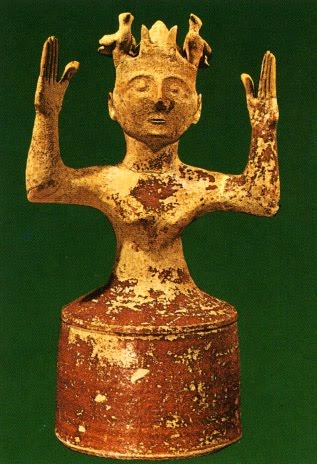
This unique stance is
sometimes used in depictions of Mary Magdalene, suggesting an association with
the Divine Feminine as “Orantes.”
Two paintings by the 14th c. Italian artist Simone Martini
depict her this way:
The Way to Calvary
From the Orsini Polytych
c 1335
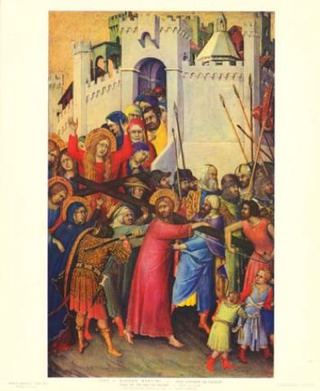
Mary Magdalene has the letter X right in front of her--one of the pre-eminent symbols associated with the alternative Christians of the Middle Ages so ruthlessly persecuted by the Inquisiton for their heresy which included belief that Jesus and Mary Magdalene were lovers, possibly based on the Gnostic Gospel of Philip which states that Mary was the koinonos, the companion or consort of Jesus, whom he kissed often, causing the other apostles to ask, “Why do you love her more than us?” Like the famous icon of Our Lady of Czestochowa, Mary Magdalene appears to have a scar on her right cheek, reminiscent of the text from Micah 5:1: “With a reed, they strike the cheek of the ruler of Israel.”
The Deposition
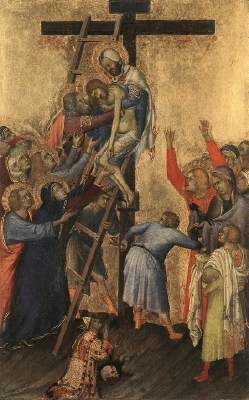
This painting of the Deposition (taking Jesus off the cross) by Simone Martini is another panel of the Orsini Polytych.
Again, the Magdalene’s arms are raised in the classic pose of the “Orantes”—the one who prays for the deceased. The prevalence of this image often carved on Christian sarcophagi suggests the role of “psychopomp”—the one who accompanies the deceased into the afterlife.
Another interpretation is that the image depicts the soul of the deceased rising into heaven. It is interesting to note that this same "pose" is called the "distress signal" in Freemasonry, used to identify brother masons in trouble.
We come now to an altarpiece comprised of statues at the Basilica of Saint Remi in Rheims. The grouping is sometimes called a “Templar” altarpiece.
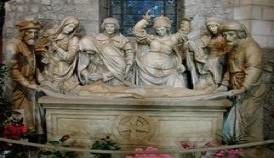
Notice the circular medallion containing the equal-armed cross of the Knights Templar Order at the front of the altar. Jesus is resting on his shroud, a length of linen owned and venerated by the Knights Templar in the 13th century. The grouping is derived from the Gospel narratives that describe Joseph of Arimithea, Nicodemus, the “Beloved Disciple” (whom the Templars identified as Lazarus of Bethany), and usually four women including the Blessed Mother, Mary Magdalene, and two others, probably Martha and Salomé. According to French legend, these same women (Mary “Jacobi,” the mother of Jesus but also of his brother James, Mary Magdalene, Martha and Mary Salomé) later traveled together with Joseph of Arimathea and Lazarus, debarking on the shores of Gaul in AD 42, bringing with them the “Holy Grail.”
The Magdalene figurine in this altarpiece is “great”—even massive--especially with her arms raised in this “orans” position. She has adopted the ancient pose of the “Orantes” Goddess, one we find articulated in the medieval “Ave Maria” prayer to the Virgin: ora pro nobis—“pray for us sinners, now and at the hour of our death.”
* * *
02-04-12
Medieval Symbolism
An interesting article was posted last week about the drawing of "Vitruvian Man" by Leonardo: http://www.msnbc.msn.com/id/46204318
I wasn't particularly interested in whether or not Leonard had copied the Vetruvian man drawing from his friend, but I was very interested the comment about the "circle" and "square" in symbolism:
"Both drawings are depictions of a passage written 1,500 years earlier by Vitruvius, an ancient Roman architect, in which he describes a man's body fitting perfectly inside a circle (the divine symbol) and inside a square (the earthly symbol). "
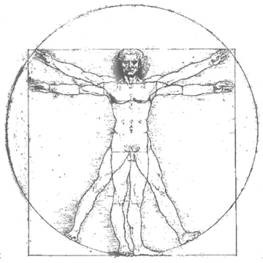
With this symbolism of the "irreconcilable opposites"--circle and square representing "the divine" and "the earthly" (spirit and flesh)--please see the photo of a 13th century drawing of the "Fishes" representing the "Sacred Marriage":
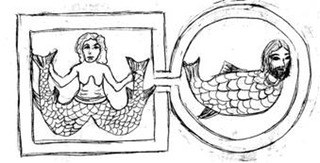
This drawing was rendered from a photo I took in a Historical Museum in Metz, France. The original was painted on the wall of a building in that medieval town in about 1250. The perimeter of the square and the circumference of the circle are the same in the original drawing--representing the "union of the irreconcilable opposites," a symbol for "Sacred Union" in sacred geometry. The male and female images in the painting are also linked.
The bearded fish is, IMO, a clear reference to Jesus as the "Ichthus"--the "Fish" that is the symbol for Christ, now a familiar bumper sticker. The double-tailed"mermaid" has numerous associations with Mary Magdalene. She's now on nearly every street corner worldwide, via the "Starbucks" logo! Numerous mermaid watermarks are found in antique bibles and books (as described in my "Tarot Trumps" book. An article I wrote about the "little mermaid" associations with the Magdalene legends is posted here:
http://ramon_k_jusino.tripod.com/littlemermaid.html .
Interestingly enough, the town of Metz is the ancestral home of the Merovingian monarchs (5-8th c), whose legends include descent of their ancestor Merovée from the liaison of his mother with a "sea creature--half man, half fish." Might this drawing be a symbolic family portrait?
Here is an amazing stained glass window from Winchester Cathedral depicting the Lord and Lady of the Fishes.
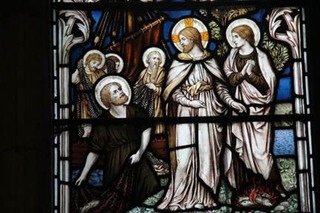
The two fish in the flames beneath Mary Magdalene's feet are suggestive of the zodiac symbol for Pisces. Rather than swimming side by side, these fishes are crossed, forming the letter X (the pre-eminent symbol of the alternative “Grail” Church). The scene in the window is taken from John's Gospel, chapter 21: Jesus is cooking fish on the shore and tells his disciples to cast their nets over the "starboard" side. Their astonishing catch is "153 fishes." Did someone actually count the fish in the net? Not likely. The "153" is a highly significant number in sacred geometry, a number associated with the Vesica Piscis ("vessel of the fish") and with the goddesses of love and fertility. It is also Mary Magdalene's "sacred number" by gematria of her Greek title "H Magdalhnh."
For further information, please see my webpage about Circles here.
peace and well-being,
Margaret
COPYRIGHT 2012. MARGARET L. STARBIRD. ALL RIGHTS RESERVED
